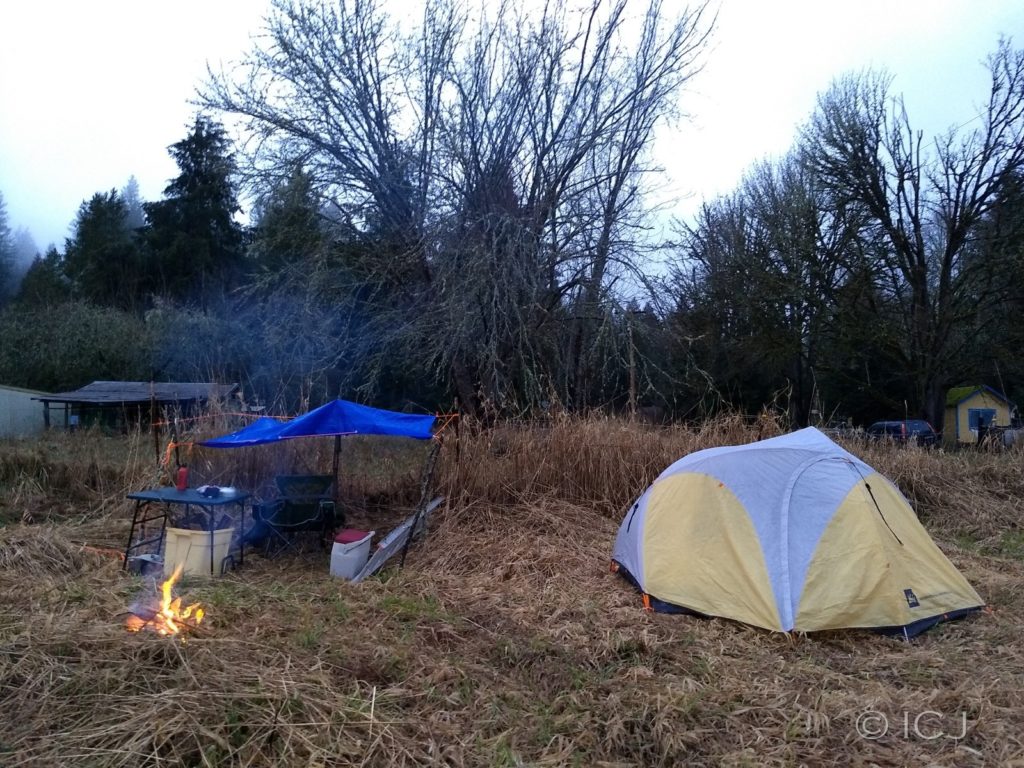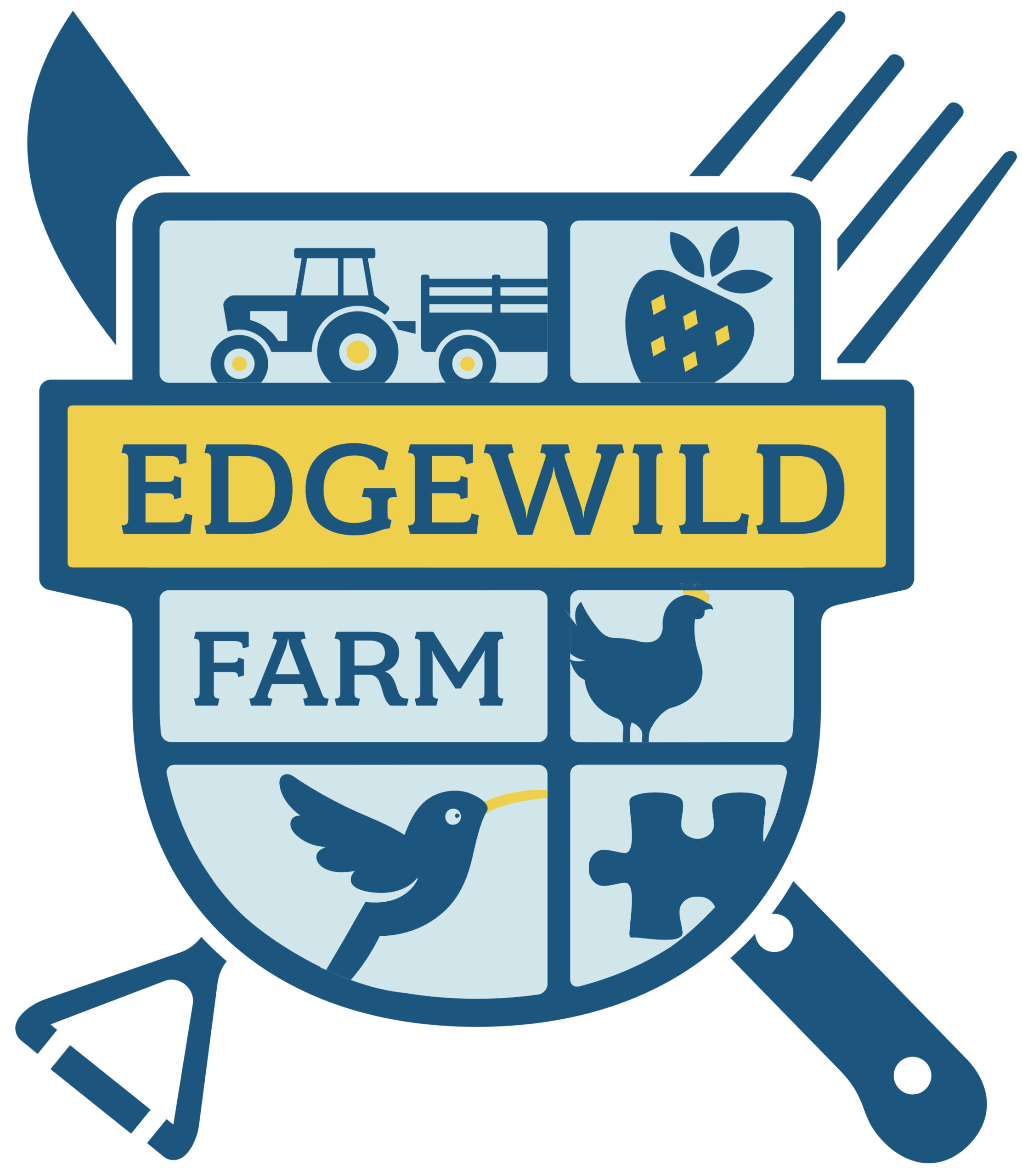State Fare
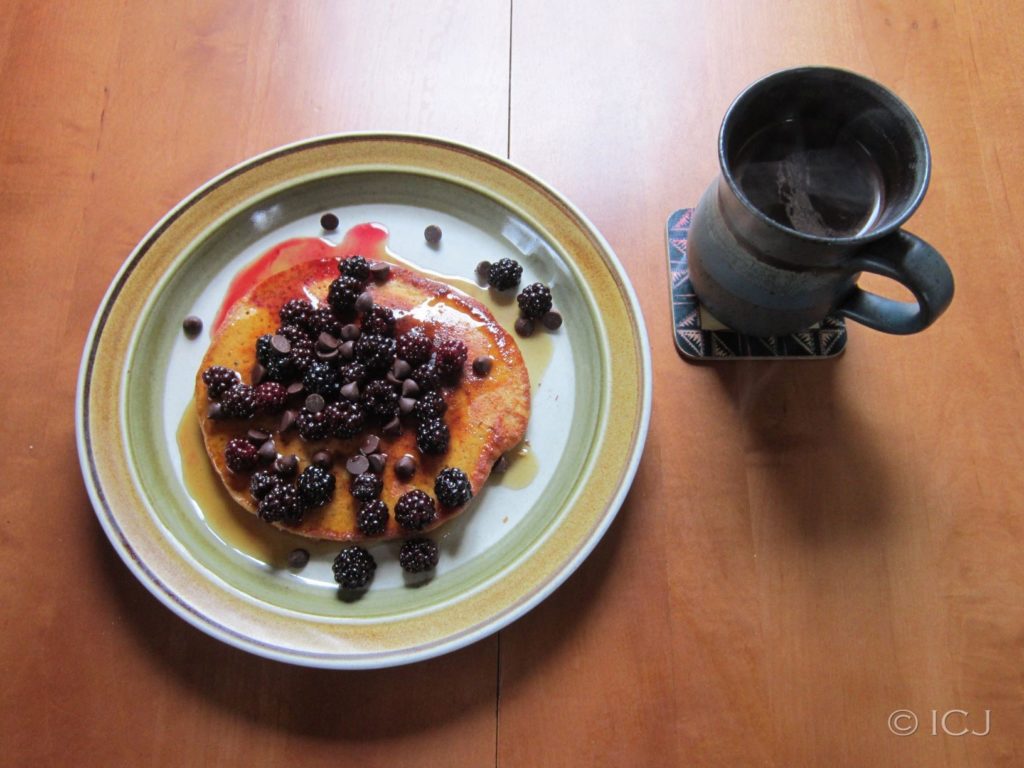
My first experiment in eating local took place in spring of 2010, six full weeks in March and April. Strangely enough it was my first time observing Lent and I was doing so shortly following my departure from formal religion. For a recovering Evangelical, perhaps practicing a ritual dearer to Catholics than Protestants was a form of protest? Of repentance? Of exercising religious freedom? When you don’t adhere to a particular creed you are at liberty to participate in any tradition that feeds your soul.
I don’t remember what prompted the parameters that I set. At the time I was severely cash strapped, having gone through several rounds of unemployment without benefits and jobs falling through in the recession of 08-09. I was working low-wage jobs with erratic hours in a city where cost of living was already problematic. Even at 40 hours a week between two part-time jobs, minimum was not living wage. Encumbered with crippling student debt—monthly payments were more than rent at the time—I had to work more that 40 hours a week to have any margin at all. That option was not always available to me.
For most of the past year and a half my grocery budget had been $30-35 a week. Many meals of just rice and lentils, with sometimes a little cabbage on the side. Many meals of apple, homemade bread, and a few slices off a 2-lb block of the cheapest Tillamook Cheese.
I decided for Lent to eat only food grown in Washington State. I decided that my budget for doing so would be $50 a week. I had a 3-figure checking balance at the end of a good month. This was a risk, and a splurge.
Making a substance or behavior taboo is typical Lenten practice. Rather than giving something up I was committing to something. Putting my money where my mouth is. Investing in the integrity of the food system. Not self-denial for self-denial’s sake but excluding some things to make room for other (and worthier) things. One only has so much space in one’s life. Choosing abundance. Choosing mindfulness. Choosing gratitude. Repenting of, or if you prefer non-religious language, ‘turning one’s back on’ scarcity, carelessness, and greed or fear.
The daily imports I allowed myself were coffee, olive oil, yeast, and spices. I allowed for 3 exceptions each week—snacks or meals consisting of food from outside WA—but they had to fit withing the $50.
Carless, as I had been for going on 5 years, I biked and/or bussed from Shoreline to the UDistrict Farmer’s Market which is open every Saturday year-round. For the first time I foraged for whole portions of greens rather than just nibbling because the field guide said it was edible. Seattle has some generously sized and largely wild (2nd-growth but not landscaped) city parks.
I went hungry a lot.
I believe it was about halfway through the six weeks that I manage to find and afford all the ingredients for honey wheat rolls. I mas moved almost to tears by the smell of them rising. I have never been so grateful for bread.
Remembering this I wanted to make sure that I had the ingredients for honey wheat rolls before State Foodshed Day came along. Bluebird Farms popped up online. A) Bluebirds are my second favorite bird after hummingbirds, and B) The farm is, as they describe it, a plow-to-package operation. I loved their philosophy and the way they present themselves. The sampler pack seemed like a good way to start—2 lb bags of flour of five different kinds of grain. So far SOOOO good. I look forward to trying them all and finding my favorites for each recipe. Someday when I have more storage, specifically another chest freezer, I hope to buy the majority of my flour from them.

April 24 – WA State Foodshed Day
**All food grown/raised/foraged/hunted in WA excepting imports allowed on Homegrown days (coffee, olive oil, salt, and yeast) + County and State days (chocolate, butter, maple syrup, and spices that do not grow in WA).**
State Food Day dawned cool and soggy after a week+ of unseasonable warmth and drought. Perfect for cozying up in the cabin, preparing and savoring comfort food. First order of business: PANCAKE! Because pancakes.
Breakfast: Blackberry Chocolate Chip Pancake, Coffee
Pancake = Egg (Root Cellar Farm, 15 miles), kefir (Grace Harbor Farms, 211 miles), einkorn flour (Bluebird Grain, 295 miles), maple syrup (sub for the sugar), baking powder, salt.
Toppings = Blackberries (home), dark chocolate chips (Equal Exhange via PCC).

Growing up, pancakes were Swedish pancakes, which are more like crepes. Making them is a production—totally worth it, but reserved for things like Saturday brunch with all of the family or roommates around, or guests over for a breakfast-for-dinner. American pancakes happened most regularly at summer camp. 7 summers on staff x 4-10 weeks x pancakes twice a week. Better slather that with peanut butter or you’ll be bonking by 10 am. No morning snack break and lunch isn’t till noon. American pancakes belonged to camp and breakfast at diners on family road trips to CT or CO to see the grandparents, one direction or the other every summer.
I don’t know why it took me until I was 30 to realize that one of the best reasons to be a grown-up was having pancakes whenever you want. Swedish pancakes don’t make sense for fewer than 4 people but American pancakes need not be a meal for 100. I fiddled with a combination of several from-scratch recipes until I had perfected the batter of a Pancake for 1.
The kefir was an accident. One time a couple years into my pancake renaissance I didn’t have milk or half-and-half around. Kefir in pancakes is now a fixture. They are richer and fluffier that way. Yogurt works too but they turn out more dense. I’ve been buying the Grace Harbor Farms kefir for years. They are a small, really actually family farm, good keepers of land and animals, and minimally process their dairy to keep the nutrients intact. You can only buy their stuff in WA.
Later I discovered the excellent all-natural Bob’s Red Mill pancake mixes and usually have one of those around. Just 1 egg, a dollop (1/4 c?) kefir, and 1/3 cup of the dry mix. Pancake. Done.
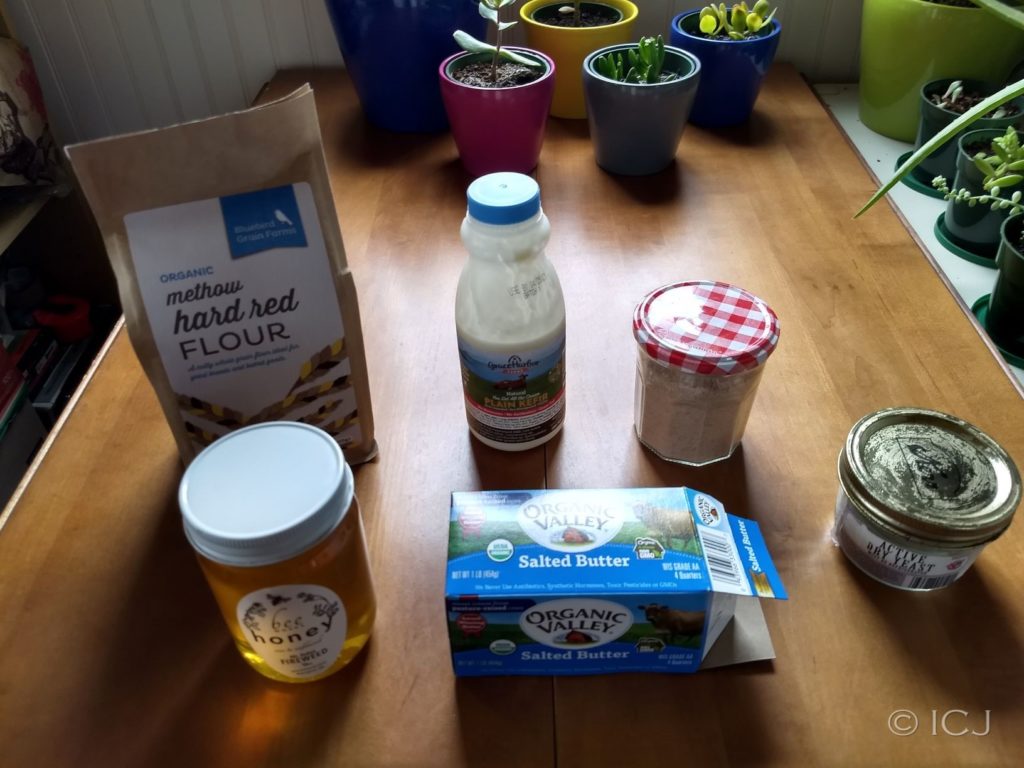
Honey wheat rolls = Hard red wheat flour (Bluebird), kefir (Grace Harbor), water, honey (Beeworks, 192 miles), butter, salt, yeast.
The recipe calls for 2 c milk. I substituted 1 c kefir and 1 c water because I wasn’t in Seattle recently enough that milk would keep. Strange with all the dairies around here that you can’t find any WA-label milk on the shelves. The Farmer’s Market in Morton doesn’t start until May or the one in Chehalis until June.
The bread recipe is out of a cookbook that I bought in Sweden while an exchange student, their answer to Betty Crocker, or more accurately, splitting the difference between Betty Crocker and Joy of Cooking. Every Swedish household has one.
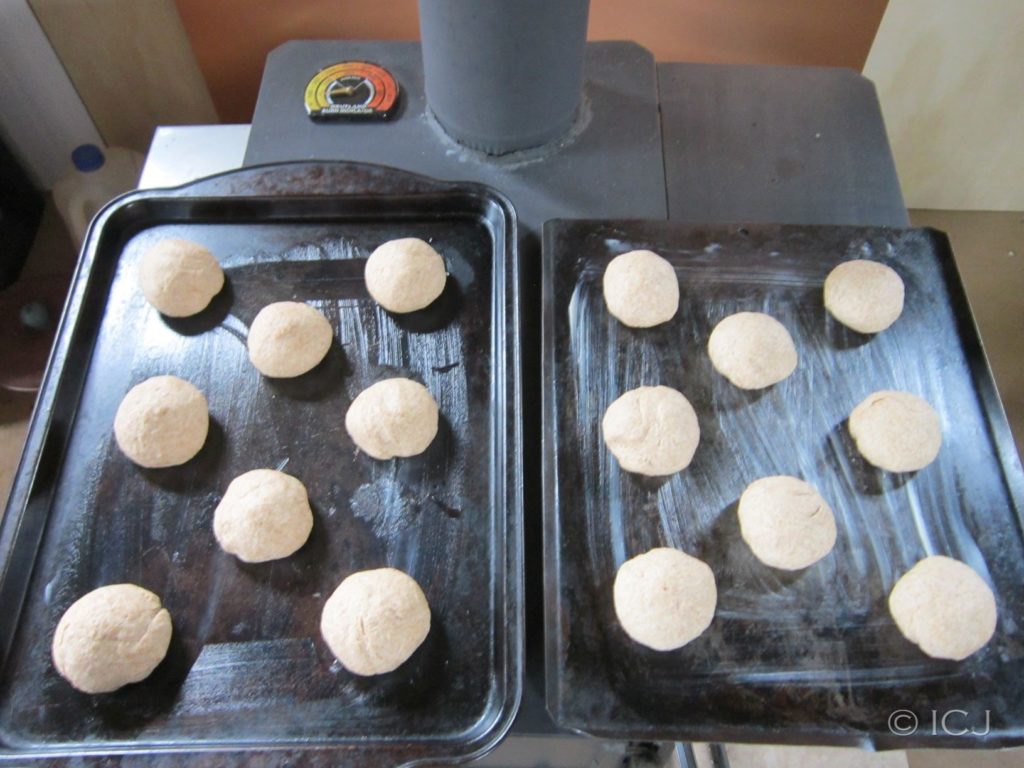
I baked the rolls in an oven given to me by a neighbor (salvaged from remodel). It is housed on a pallet in a funny little 3-sided shed with salvaged window panes, built for the purpose. My neighbor said it looks like a bus stop. It totally does. Michelle, who helped me build the shelter, named it Thistle House. It took three tries before I figured out the right combination of hose and brass fittings to run a household oven off a 20-lb propane tank. Fortunately it was already being run on propane instead of the default natural gas so I did not have to swap out the valves inside as well. Quite the rigamarole but so worth it to be able to bake. Got that thing live in January. Within a few weeks I couldn’t bake anymore for a while because my chest freezer was full.
Lunch: Potato Leek Soup, Honey Wheat Roll, Cheese
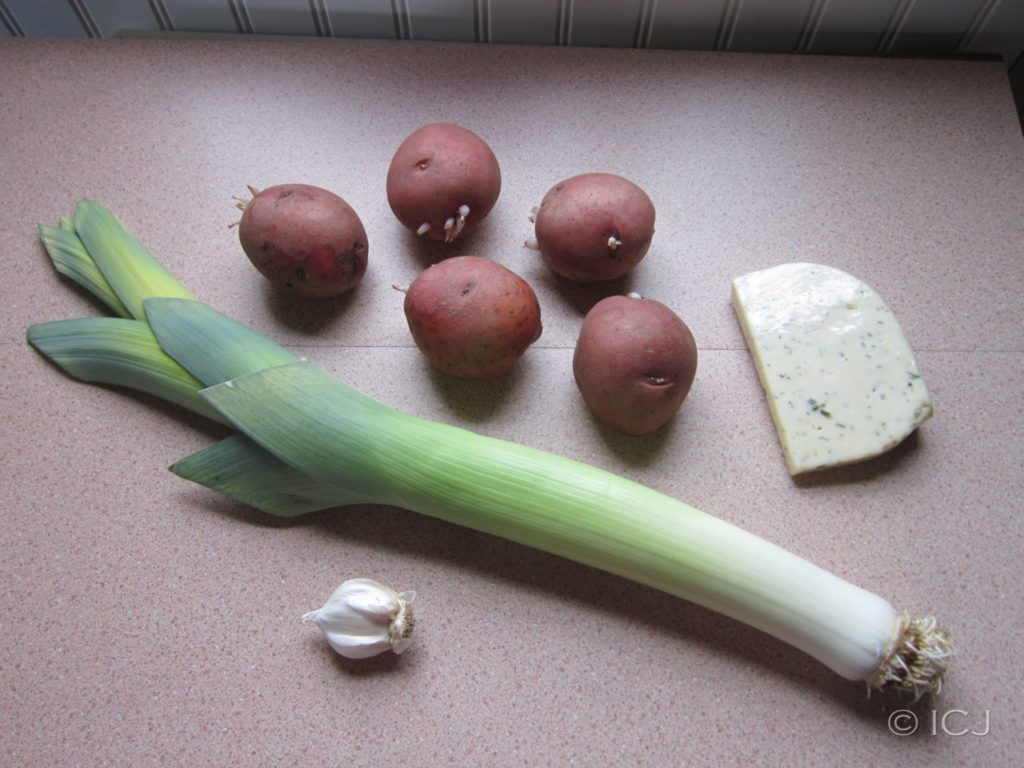
Soup = Potatoes (WA via PCC), leek (WA via PCC), garlic (Irish Eyes, 163 miles), butter, salt, pepper, cooking sherry.
The garlic comes from the remainder of a pound of seed garlic that I ordered for planting last fall. “Silver Rose” is the variety, advertised as an excellent keeper. I planted the biggest cloves from the seven most robust bulbs and kept the rest to eat. All 58 garlic plants came up and are pushing 18” high. Here’s to homegrown pesto in July!
The cheese is herb gouda from Samish Bay, 176 miles, via PCC. They are regulars at the UDistrict market in North Seattle. I bought a small wheel of their fresh Ladysmith cheese every week of the 6-week WA eating endeavor in 2010. It’s scrumptious and a great deal more affordable than the average aged artisan cheese.
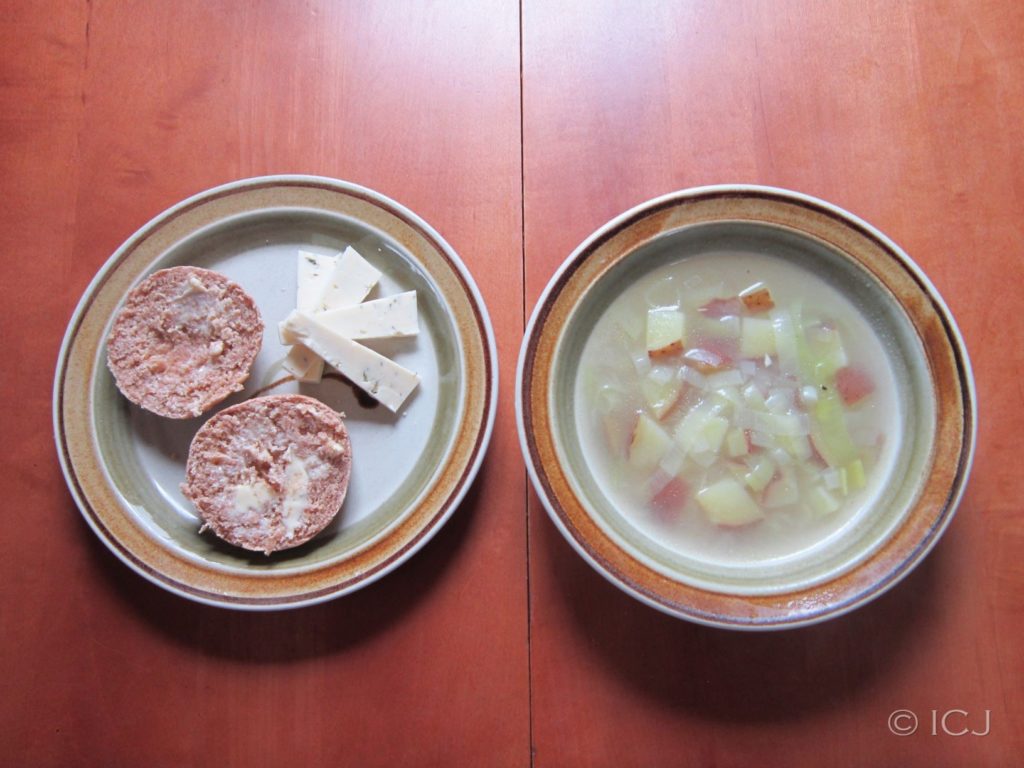
Afternoon Snack: Roll with Butter and ‘Jam’, Apple, Chocolate, Rose Hip Tea
Improv jam made of blackberries (home) and honey (Beeworks). Apple (home) now 6+ months since harvest, a month or so in the fridge after 5 months in the root cellar. Theo chocolate. Rose hips (home).
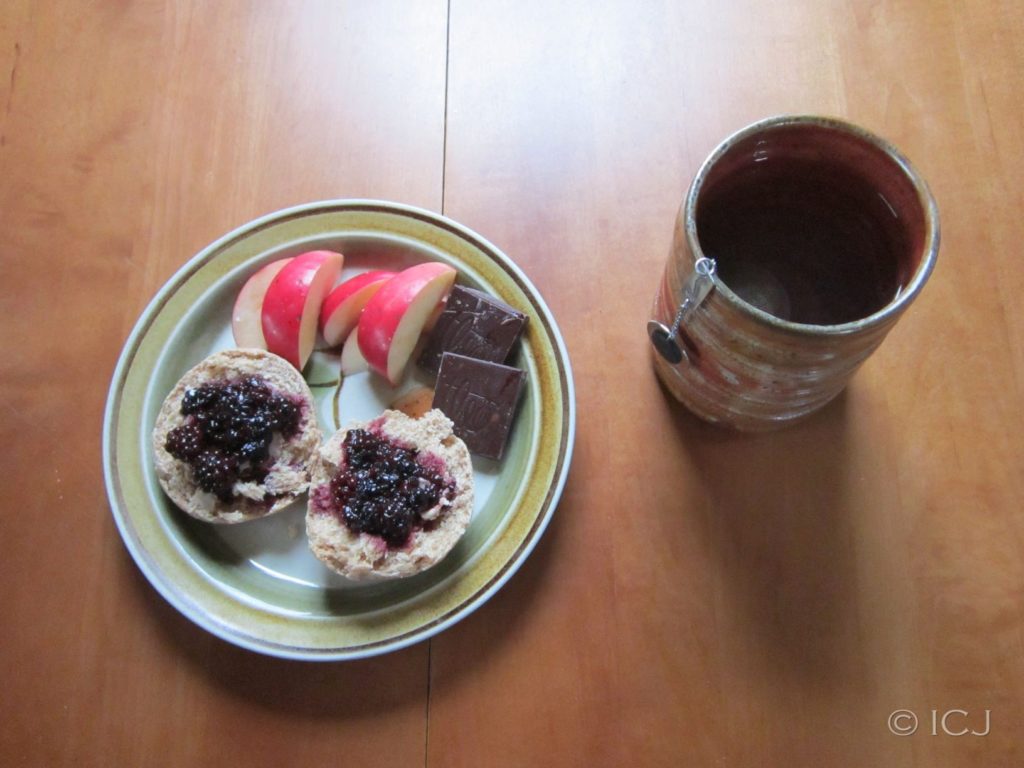
Dinner: Swedish Meatballs, Boiled Potatoes, Greens with Garlic and Butter, Hard Cider
Meatballs = Ground beef (Val, ¼ mile), ground pork (Zack and Rylee, 8 miles), shallot (home, sub for onion), bread crumbs (honey wheat roll ground in food processor), eggs (Root Cellar), allspice, salt, pepper.
The cow was raised and butchered by one of my neighbors, whose field I can see from my porch. I have visited the shed where the pig lived. Its keepers have been to my house for dinner.
I have been making my family’s multi-generation Swedish meatball recipe for years. This is the best they have ever turned out. Most of them I’ve made since I started eating meat again in 2013 were from Seattle farmer’s market beef and pork so that is saying a lot.
Potatoes (WA via PCC) with a pinch of salt.
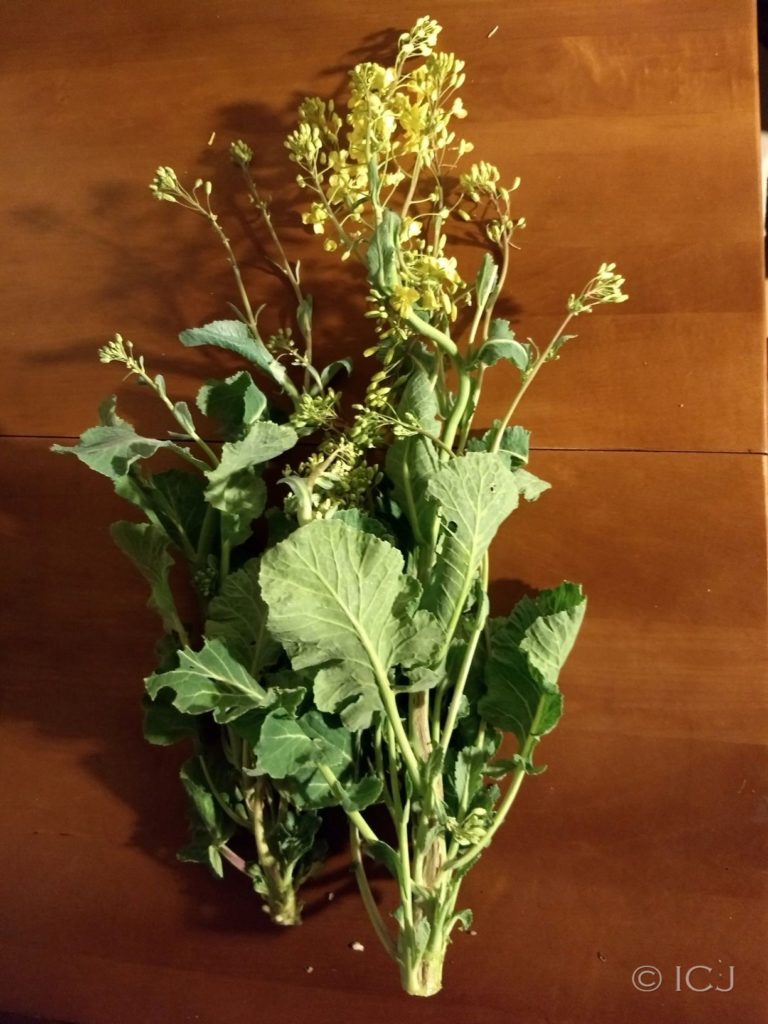
The greens I sauteed were young leaves pulled off the flower shoots of a nonsense brassica. The seed packet imagined they were brussels sprouts. Only two plants out of twelve saw fit to behave like brussels sprouts at all, and did not do a very convincing job. Several tried to be cabbages at the top of a foot tall stem. Others looked like really scraggly sprouting broccoli or kale. Last fall’s leaves were moth eaten, mouse eaten, drought stressed, and totally unappetizing. I waited to put the plants in the ground until the stems were woody enough that mice would not eat the whole thing. Had they been actual brussels sprouts I would have continued taking better care of them.
The new spring leaves were pretty good. Some tasted more like broccoli and some more like cabbage, all with the texture of young kale. Plant genetics are fascinating, especially brassicas. One species takes on a staggering number of forms and a range of flavors. If two brassica varieties are flowering at the same time in proximity, the seeds can be crossed up and turn out as whatever they please in the brassica range.

Hard cider. 2 ingredients: Organic apples (grown in Yakima), yeast. Tieton Cider Works, 122 miles. Over the Cascades and straight on til morning. This stuff is delicious. Not too dry, not too sweet. I found it at Grocery Outlet in Chehalis earlier this year and have bought it several times.
Glorified peasant food. The quality of the ingredients makes it a feast. It makes me happy to think that my Scandinavian farmer ancestors sat down in front of a plate like this many times.
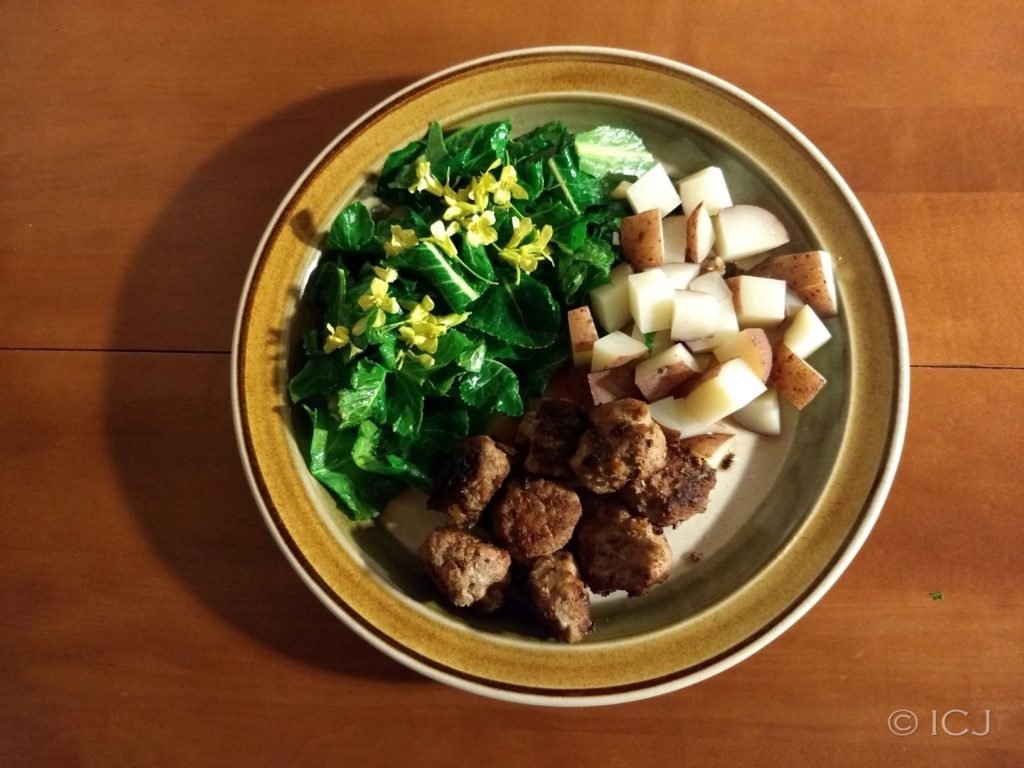
I have been conscious of the global food system and the pitfalls thereof for going on 25 years now. At the time of my first in-state eating exercise it had been over a decade, during which I had spent a fair amount of time participating in both hands-on projects and policy initiatives addressing the problems of access to sufficient nourishing food and of growing food in environmentally responsible ways.
Even so, a month and a half of endeavoring to feed myself mostly in-state left me deeply unsettled. It is arguably easier to eat local in WA than any other state in the U.S. thanks to our moderate maritime climate and two starkly different bio-regions east and west of the Cascades. It’s still a serious challenge. Without the opportunity to amass and preserve seasonal produce for months in advance, half the year it would be nearly impossible.
Food is deeply embedded in ritual. Rightly so. It seems to me that sourcing of food should consistently be approached with reverence, not just its preparation and consumption on special occasions. My vision for Edgewild is to be putting this philosophy into practice and inspiring other to do the same.
Meet the Neighbors
Barbara Kingsolver is one of my favorite authors. Her book Animal, Vegetable, Miracle chronicles her family’s adventure in eating local and seasonal for a whole year. It’s years now since I read it and the details are fuzzy but I ought to credit it with the premise of the Foodshed Challenge. I believe they settled on their county of residence as the parameter for their sources, with only a few ingredients and personal luxury items chosen as exceptions. Farm in the Southeast, committed for 365 straight rather than just 3 days a month, still the same general experiment. Get to know the sources of your food and its cycles, its schedule. Source your food from places you can see, from people you could know.
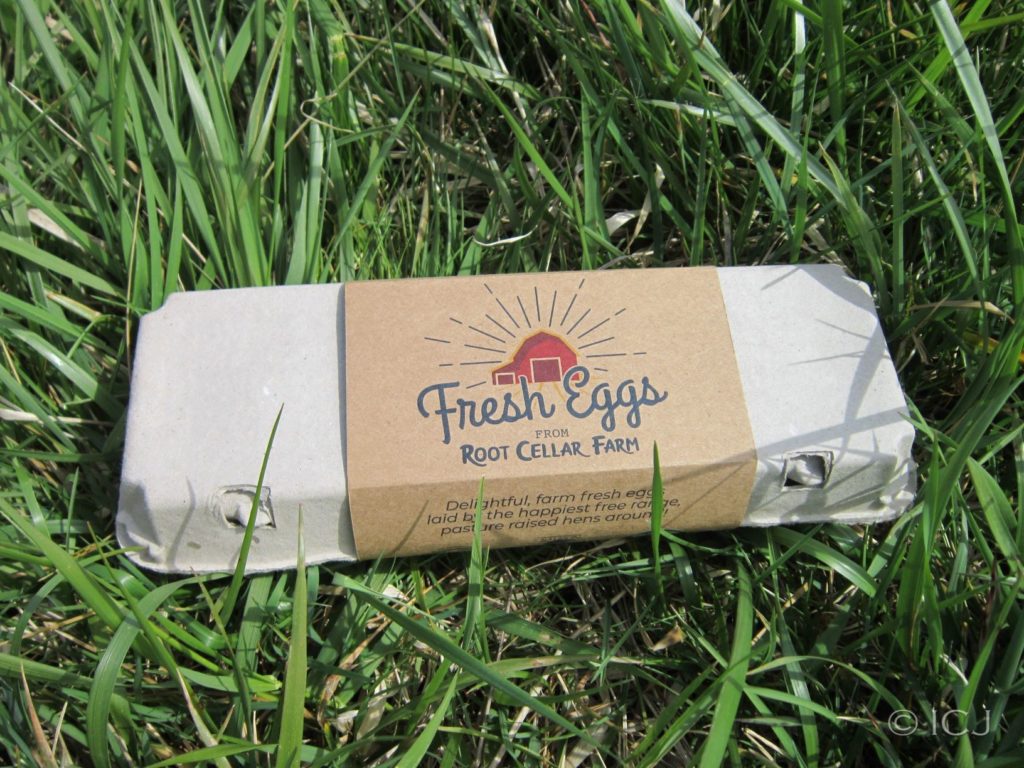
I met the good people of Root Cellar Farm in Onalaska through a mutual friend last spring. They run a mostly vegetable CSA and have a booth at the farmer’s market in Longview. They also had an on-site farm stand last year though are setting that aside in ’21 to focus on other things. I have done several mornings of work trade for produce credit with them and got invited to a few picnics last summer and fall. Being the new kid in town during quarantine, living alone and sometimes going days without seeing a human face, I was starved for social interaction. It was delightful to have a way to be around like-minded people with the casual camaraderie that shared manual labor tends to entail. The chicken eggs, butternut squash, beets, and garlic featured in the April county foodshed meals all come from them. The eggs I got fresh last week. (Check out their fancy new packaging—oooh!) Everything else kept in my root cellar or pump house since September or October of last year.
April 10 – County Foodshed Day
**All food grown/raised/foraged/hunted in Lewis County, WA excepting imports allowed on Homegrown days (coffee, olive oil, salt, and yeast) + County and State days (chocolate, butter, maple syrup, and spices that do not grow in WA).**
Morning of April 10 it was snowing and the day barely and briefly broke 50. April 17 as I wrote the first draft of this by hand (I can’t write well on computers, I can’t think well in front of a screen) the high was 82 and it felt great to sit still indoors out of the sun.
Breakfast: Scrambled Eggs, Coffee
Chicken eggs (Root Cellar Farm), butter.
If the butter is Organic Valley, it is pasture raised and sourced from small farms somewhere in the Midwest or PNW. If the butter is Kerrygold, it’s from Ireland and it’s amazing. I have no intention of ever entirely giving up Trader Joe’s. For years I bought Tillamook butter but a couple years ago they did something to make it “extra creamy” which made it both taste like plastic and disagree with my innards. One or two seasons many years ago there was a dairy at a north Seattle farmer’s market that sold butter that they farmed. Butter is not something I’m inclined to mail order or drive more than 10 miles out of my way to acquire so until I find a worthy nearby source, Organic Valley or Kerrygold it will be.
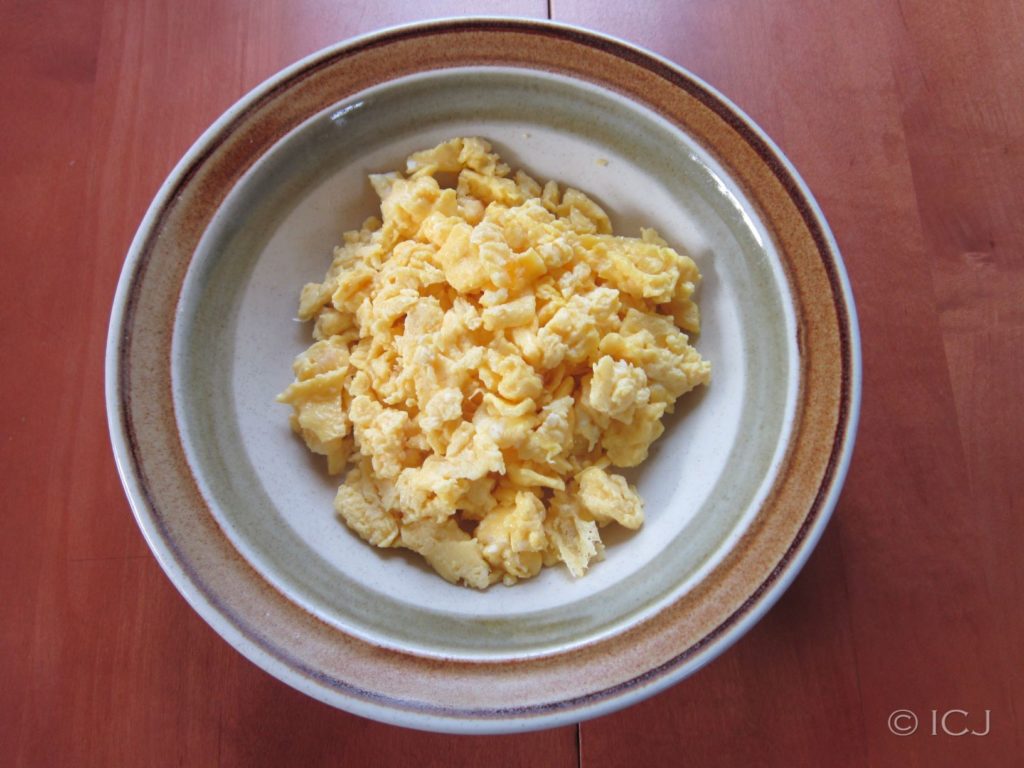
Morning Snack: Apple Leather 2.0, Rose Hip Tea
This time I pureed the apple mash and put plastic wrap down on the dehydrator trays. Cleanup was sure a lot easier and the fruit leather came out in one piece. It took much longer to dry and did so unevenly. And, plastic. Meh. I really try not to use disposable plastic. I just bought parchment paper for round 3. Home compostable and chlorine free. Winning. Plus, it’ll breathe.
Rose hips are beautiful. You could use a jar or a dish of them for decoration if you had space for that kind of thing. I have a whole stand of them—they’re the fruit of the wild rose—I harvested them last fall when they were still plump and starting to turn bright red, after a hard frost but before the winter sogginess had totally set in. I took less than 20% of what was there and left the rest for the birds. They dried admirably on glass plates set beneath the belly of the wood stove. This took about a week. I had them in paper grocery bags for a day or two before I had time to pick them off of their stems. The tea is mildly tangy and fruity and extremely high in Vitamin C. I usually mix it with chamomile and a little honey but it is pleasant enough on its own.
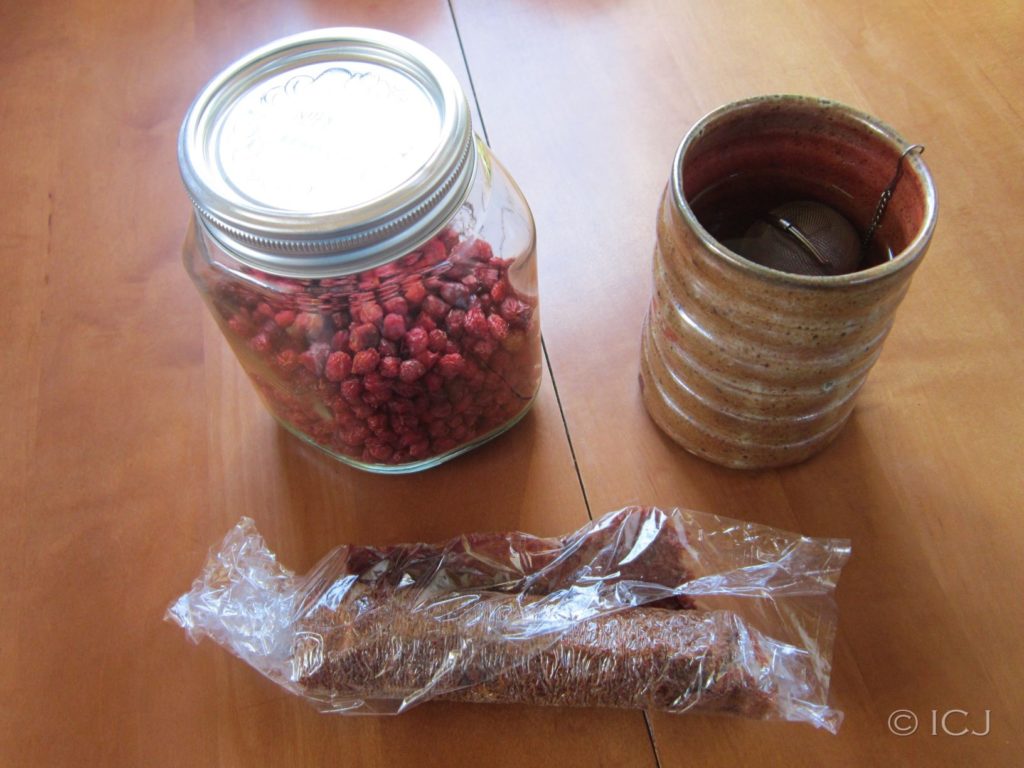
Lunch: Butternut Squash Soup, Egg Salad, Apple
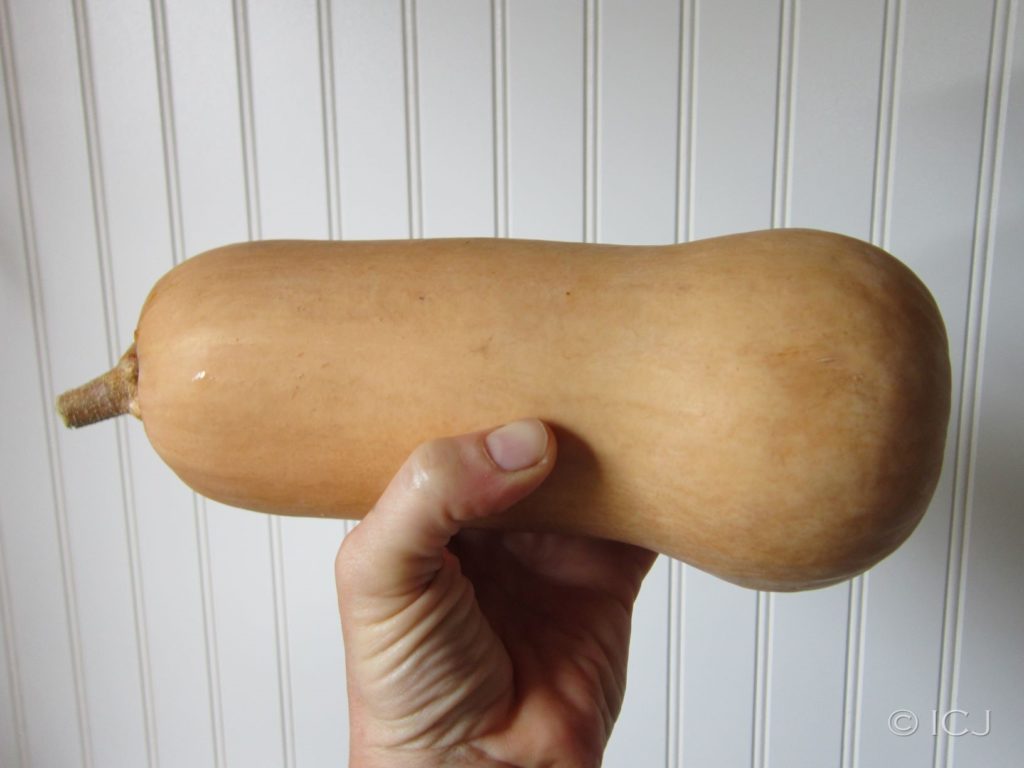
Butternut squash (Root Cellar Farm) cubed boiled and pureed, rosemary (home), cardamom (PCC, and before that ?), cooking sherry (Safeway, bottled in IL—maybe in 3 years when this 16 oz bottle is gone I’ll be making my own), salt (Really Himalayan? Who knows . . .), parsley (home) for garnish.
Hard boiled duck eggs (Rylee), olive oil (Tunisia and Spain), lemon juice (CA via PCC), chives (home), and a pinch of salt on a bed of kale (home) and sheep sorrel (home).
Apple (home).
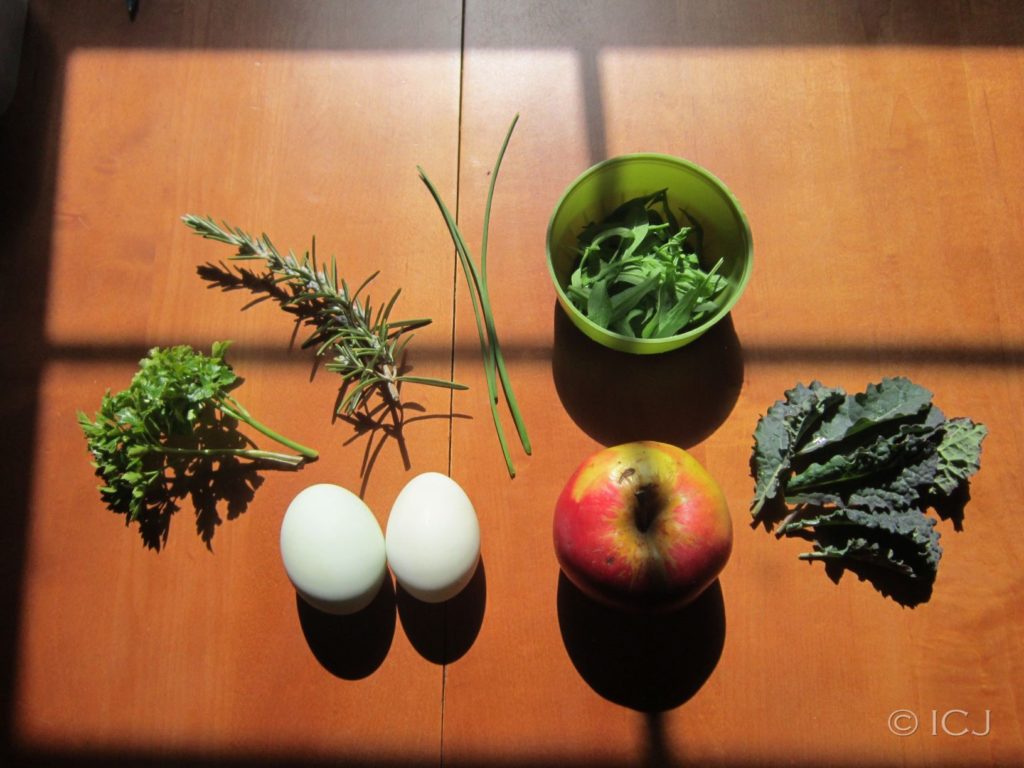
The duck eggs are from Mossyrock, about 15 minutes up the road. My new friend Rylee is just getting into homesteading herself but has kept livestock for several years and is new to gardening, quite the reverse of me. We will be able to trade knowledge as well as surplus. I bartered homemade cookies for these. Duck eggs have a richer, creamier texture than chicken eggs and a subtle gamey flavor. They are excellent in general but especially superior to chicken eggs hard boiled.
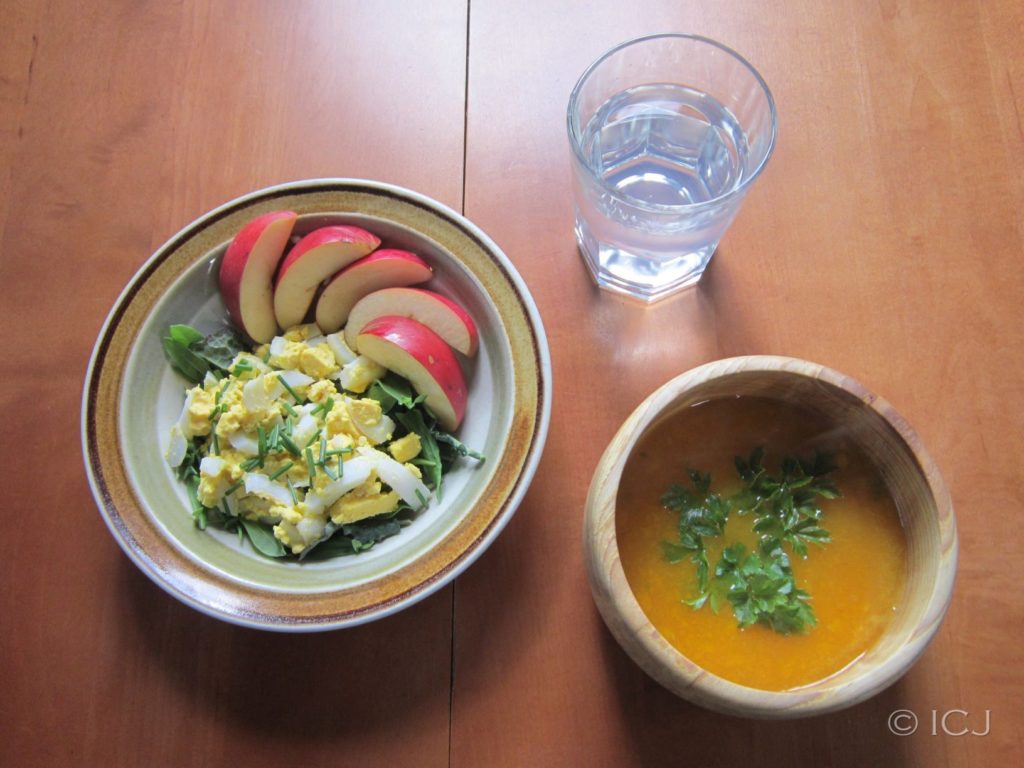
Afternoon Snack: Blackberry Sublime, Double Mint Tea
If one is going to be playing with one’s food, one might as well have fun with names in the bargain. Consider it a sundae without the ice cream. Blackberries (home) topped with maple syrup (USA and Canada via Grocery Outlet) and two squares of Theo Sea Salt Dark (raw bean to wrapper at a little factory in Seattle—I’ve done the tour several times). Next time you eat chocolate, thank an Aztec. Considering the absurd quantity of this substance that I have consumed in my lifetime I probably own their gods a shrine.
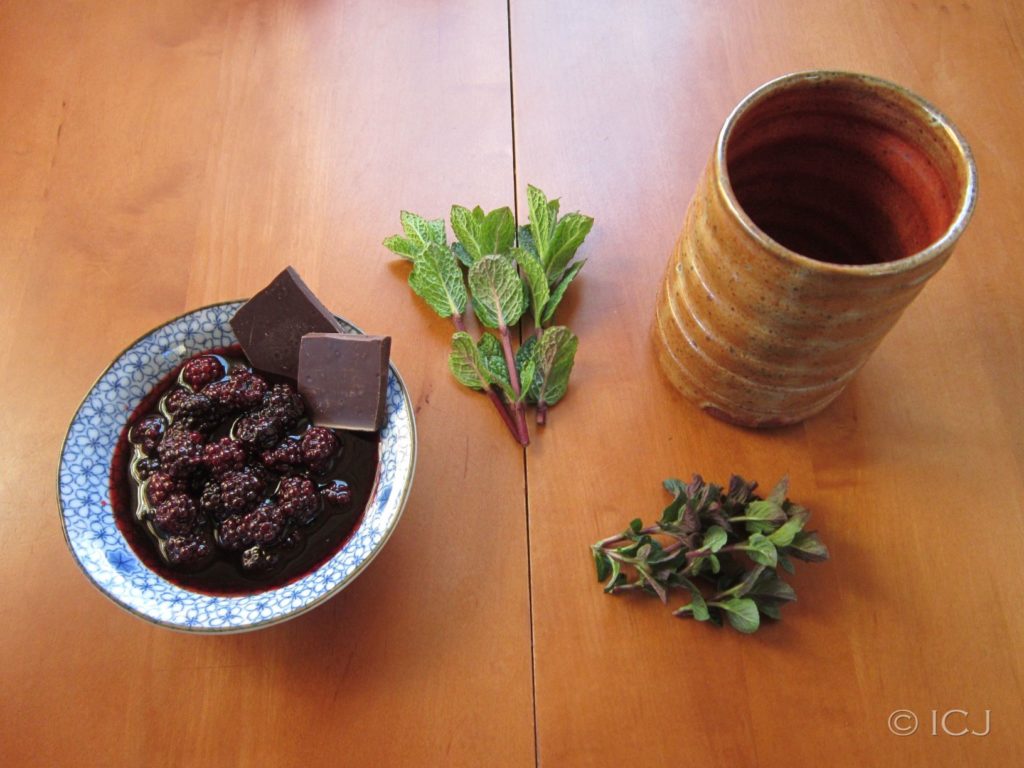
Fresh sprigs of mint, varieties ‘Chocolate’ and ‘Mojito’ because that is what the garden center had when I was buying herbs last spring. I enjoyed token garnish amounts last year of one kind or the other. They’re even better in combination. Today’s harvest, the first of the season, exceeded the above-ground biomass of the little starts a year ago. They were still in 3” pots through late spring, up to 10” pots by fall, with dense roots but still somewhat sparse greens. Around the beginning of April they started going bonkers. I moved them into 10 gallon half-barrel pots a couple days ago. At the rate they’re growing they will fill those in a couple months. Mint for days. If you don’t keep mint in pots you will never be able to take it back. I put the fresh sprigs straight in the mug and poured in hot water just off a boil.
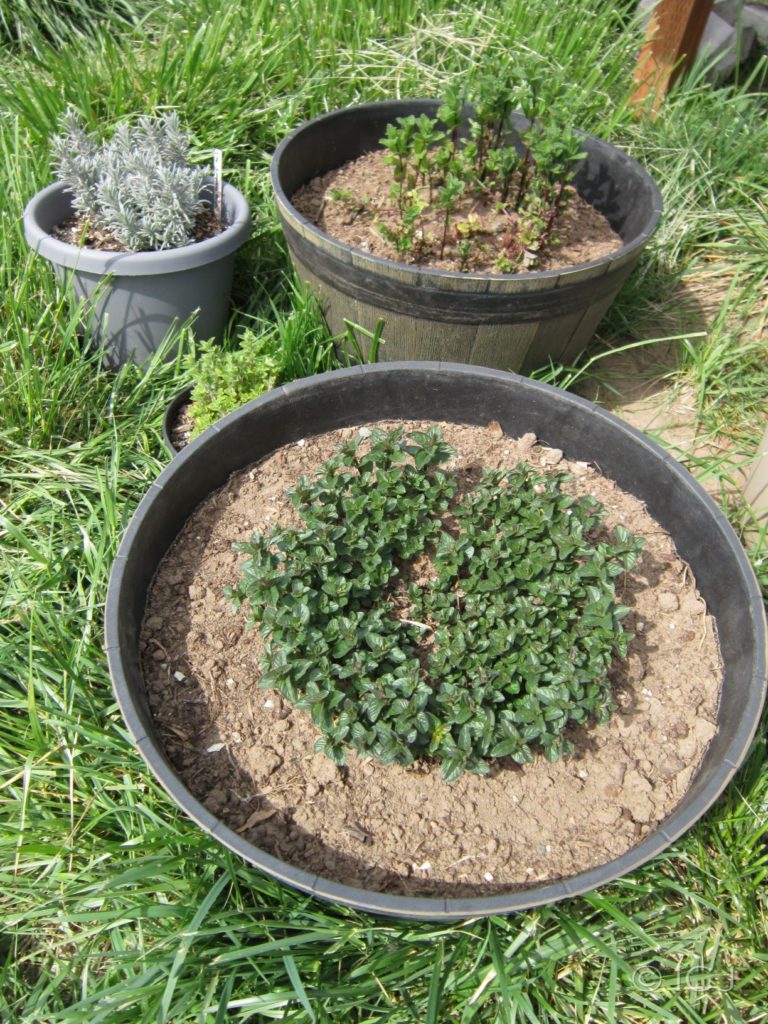
Dinner: Venison Burger with Chanterelles, Fried Beets, Dandelion Greens, Cider
My mechanic hunts with his sons, butchers the elk and deer at home, and fills a chest freezer to keep his family in meat all winter. I traded him a large bag of apples for several pounds of game which I have been keeping in my chest freezer for special occasions. The rest of the pound-odd of ground venison left after making one burger went into a stroganoff then next night.
Last fall I had the honor of being invited mushroom hunting with friends who run the marina up the road where I go once a week to get an 8-minute hot shower for $1. I came home with 2 lbs of chanterelles. These had been sauteed in butter and frozen in a small glass jar. Warmed on the stove top they tasted good as new.
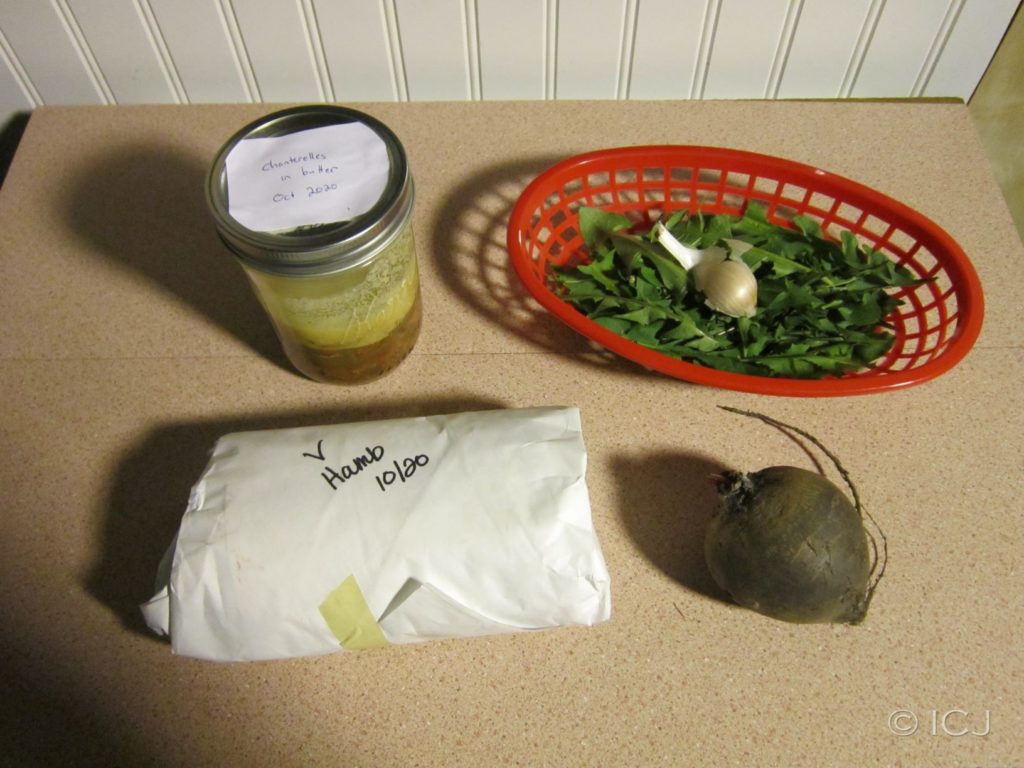
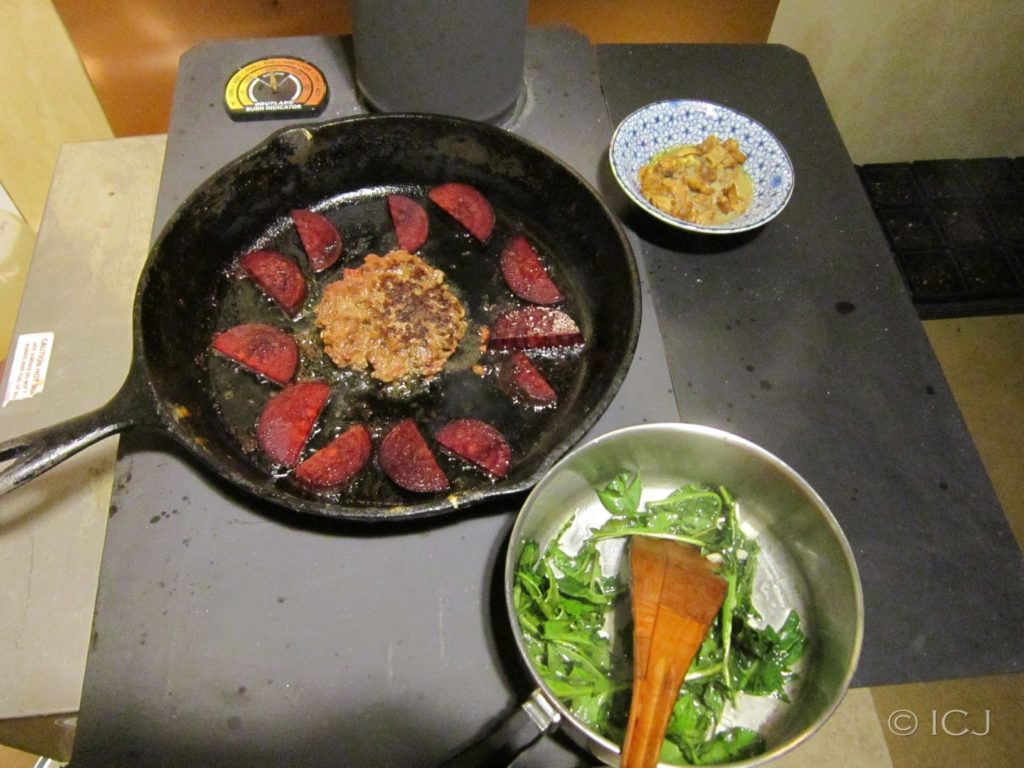
Beets (Root Cellar Farm) sliced thin and dipped in olive oil, sizzled in the frying pan until barely brown on either side.
Dandelion greens (home) rinsed and sauteed in butter with minced garlic (Root Cellar Farm) and a pinch of salt.
A cup of home-grown and pressed apple cider, frozen day-fresh and thawed yesterday. I bought a 5-gallon hand crank press that looks like a barrel with gaps between the slats. One batch yields about 3 quarts of cider and 3 gallons of mash. Cider pressing gets its own story in the fall.
Now THAT is a dinner.
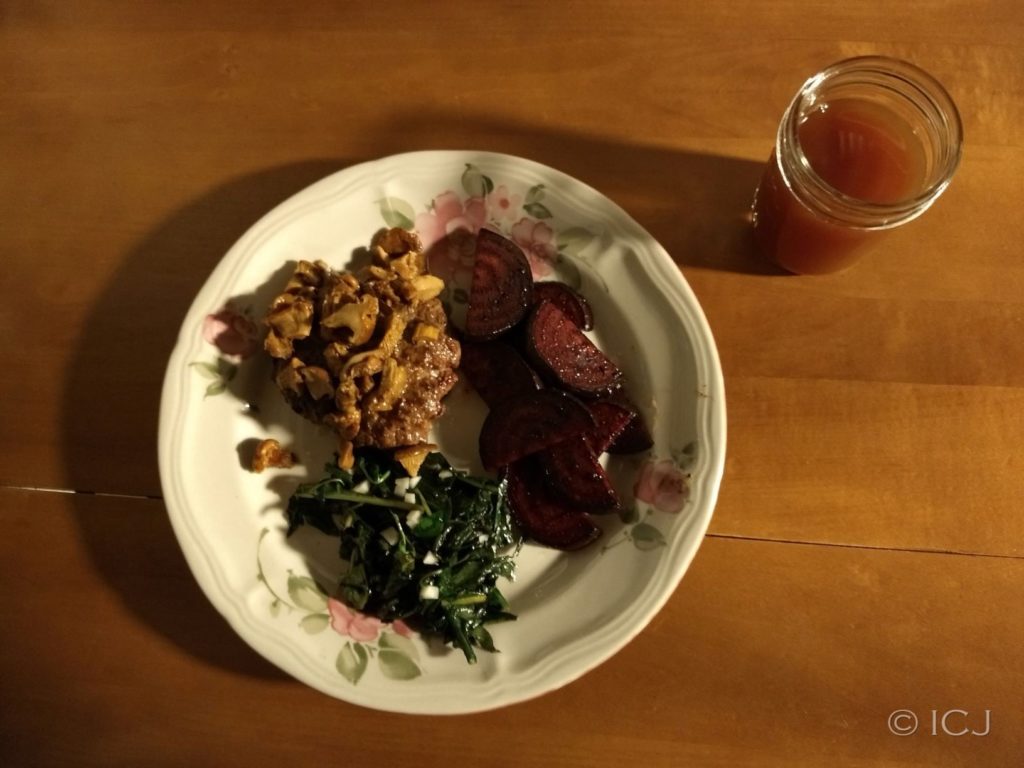
Lest there be any doubt, it is the plants keeping me alive more than the other way around. Body and soul. The plants feed the animals who in turn (if things are not mis-managed) feed the soil by their droppings and their deaths. For my living here, my ability to make a go of it and to enjoy it, I owe a debt of gratitude to so many humans as well, only a fraction of whom received mention today for their direct connection to my meals.
The people who owned this place before me, who planted that apple tree 50 years ago and built the root cellar. My neighbor who drove me to see the mechanic when my car suddenly broke down last July. A different neighbor who drove me to go get it after it was fixed, the AAA guy who towed it for me. Zack, who cut and split the firewood that heats my home and cooks my food, who was referred to me by my mechanic and who introduced me to his girlfriend Rylee because he thought we’d get along. The authors of my foraging books. The Japanese craftsman who forged my favorite 3-pronged hand weeding tool. How many links outward do you reach? How far back in time do you go?
Homesteading really isn’t about self-sufficiency. It’s about responsible interdependence. We are all in this together. It’s not a question of the fact of the connections but the quality, whether they are life-enriching or life-diminishing. Honor the connections. Treasure them. There is no such thing as going it alone.
The Foodshed Challenge
Eat local.

Where did your last meal come from? Who made it? How long did it take to grow? How long since it was alive? Did it live well?
Living well, and giving good lives to the beings that sustain me, is the core of why I have chosen to undertake homesteading. Living on the land. Living off the land. (Living with the land? Prepositional phrases are strange if you start thinking about them.) Making my life’s work the thriving of a particular place. Wendell Berry has much to say about love being particular. He is among my foremost literary mentors and will be mentioned often here.
Neighborliness is a part of that. Maintaining generous habitat by which to allow good lives for the creatures who were here before me and who would persist merrily without a human around. Providing nourishment for fellow humans, distributing my surplus via hospitality, barter, and sale. Removing eyesores—decades of garbage, vehicles and buildings fallen into woeful disrepair. Creating beauty. I want the air and water to be cleaner having passed over or through my little patch of Earth. I want the soil and vegetation to be richer for my sojourn here, that it may better nourish others after I am gone.
Ultimately we are all living off the land. If not our own, then someone else’s. The question is—what shape is the land in? is the land still living?—after we consume as we do.
A year ago April 1 I came to live here full time. I observed the anniversary by sustaining myself for a whole day with homegrown and foraged food. The exercise was immensely satisfying to mind and spirit. I daresay also to tastebuds. Calorie content, sustaining the physical activity level and body temperature that a typical “day off” (=not at sedentary wage-paying gig) requires of me, not so much. I desperately craved bread and cheese. Half an hour after filling up mostly on fiber I was hungry again.
I intend indefinitely to eat Homegrown on roughly the first of each month as celebration of the yield, motivation to improve what I can grow and preserve, and a qualitative way of documenting progress. Allowable imports on Homegrown days: coffee, olive oil, salt, and yeast. On roughly the 11th and 21st of the month I will expand the foodshed to Lewis County and Washington State respectively. Allowable imports on those days include the Homegrown list plus: chocolate, butter, maple syrup, and spices that do not grow in WA.
Sometimes I will just list the ingredients and photograph the prepared meals. Sometimes I will embellish. There is nothing simple about living off the land. It is hella complicated. If you spend too much time blogging you will not eat very well.
BREAKFAST: Steamed Rhubarb and Apple, Coffee
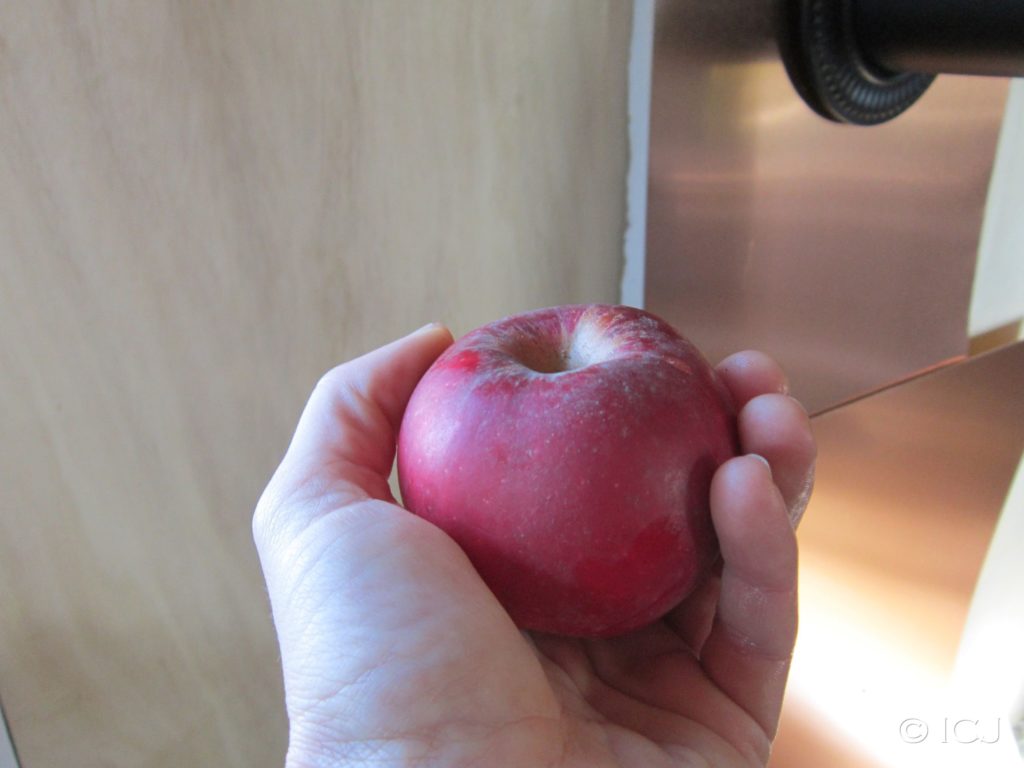
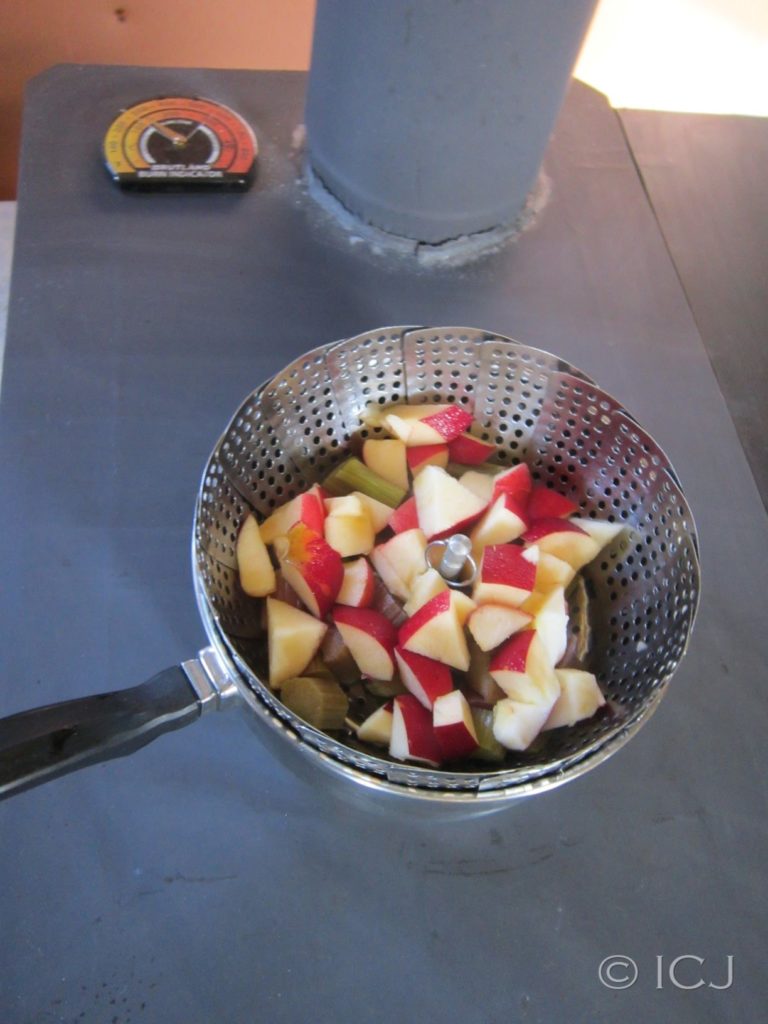
The rhubarb came from Judy’s garden. (Judy and her garden are a story for another day.) I dug up and divided an ancient plant from behind her garage. One crown had a basketball-sized root mass with any number of new shoots trapped below ground vying for space. I planted it here in March 2019. Spring of ’20 I froze about a gallon of it cubed on cookie sheets and stored in a Ziploc bag. I still have a few cups left. Before the end of the month I’ll pull the first stalk of ’21.
Apples come from Kazakhstan originally. The apple tree to which I belong is about 50 years old. It gets its own post someday. Thanks to the root cellar that has been here about as long as the apple tree (yet another story) I have a few fresh apples still edible nearly 6 months after harvest.
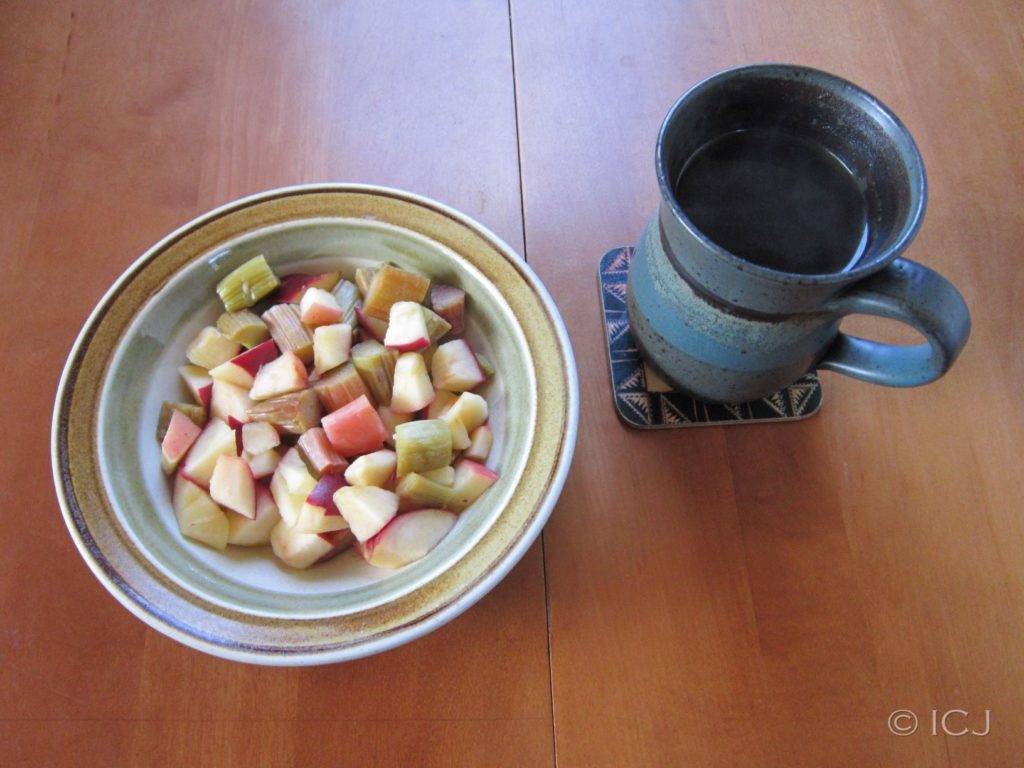
LUNCH: Raw Kale Salad with Sorrel and Blackberries, Horsetail Tea
Thanks to heavy barricades, dogged evasion tactics (nomadic existence), and the occasional tarp coverage, a few kale plants survived a year beleaguered by slugs, mice, bunnies, and temps in the low 20’s. Mixture of Lacinato and Red Russian. Both planted from seed, the Red Russian last summer in pots until they were 4” high when they went in the ground late fall due to how few of the Lacinato survived last spring being direct seeded. I moved the last two Lacinato into pots when they were 2-3” high and in pots they will remain as long as they are putting on edible leaves.
Sheep sorrel is a new discovery that I ran across in a foraging book about a month ago when I was flipping through to read up on nettles. I had pulled hundreds of clumps of it out of my raspberry beds last year not knowing what it was. It tastes just like wood sorrel, which I had previously foraged, but looks completely different and has a meatier leaf. Rather zingy, strong lemon flavor. Better in combination than alone.
Himalayan blackberries will survive the apocalypse along with the cockroaches, and that’s OK. I froze 14 lbs of them Aug-Sept of ’20. Just from my land! And blackberries are only about 2% of the vegetation here. Nearly 13 years in to living in WA I am still not quite over the fact that blackberries are free. I have spent at least a dozen hours in the past year cutting them back and extracting them from places they are unwanted, like the apple tree. I don’t really mind. The grass grows faster than they do in the spring and keeps them from taking over the world.
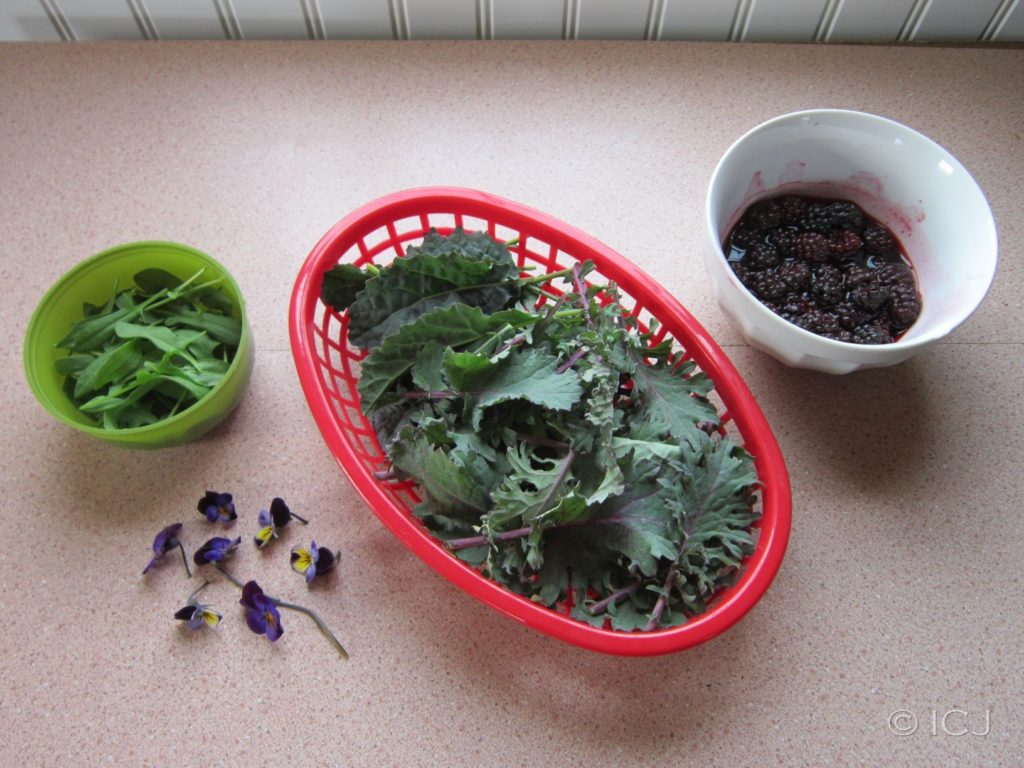
Salad dressing—Light drizzle of olive oil and a sprinkle of salt, plus some Johnny Jump-Ups for decoration. The seeds of those hitched a ride in the soil with the strawberries which I grew for two years in a raised bed at Judy’s before transplanting them here.
Beverage—Horsetail is a throwback to long before the Holocene epoch, dating back perhaps several hundred million years. Besides being one of the oldest plant species living among us it is one of the richest sources of bioavailable minerals for either soil building or medicinal and cosmetic use. It is especially good for hair and nail health. It’s a problem on pasture because grazing animals love it and the fresh leaves contain an enzyme that destroys B vitamins. Too much can cause a serious deficiency. Dried and steeped long in boiled water or yanked in its prime and tossed on the compost heap, it’s all nourishment for animal and plant alike.
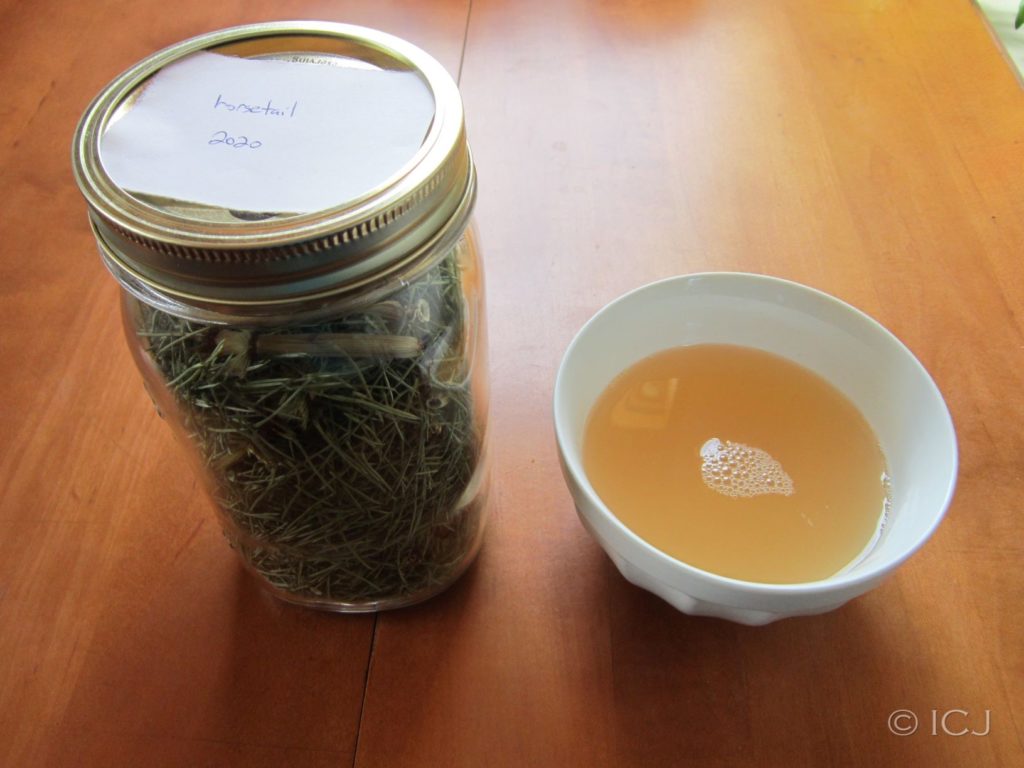
Horsetail tea doesn’t taste unpleasant alone, just mildly medicinal and even a little metallic. Better mixed with fruit juice or some other herbal tea. This time I mixed it with the juice from the steamed apples and rhubarb and served it cold.
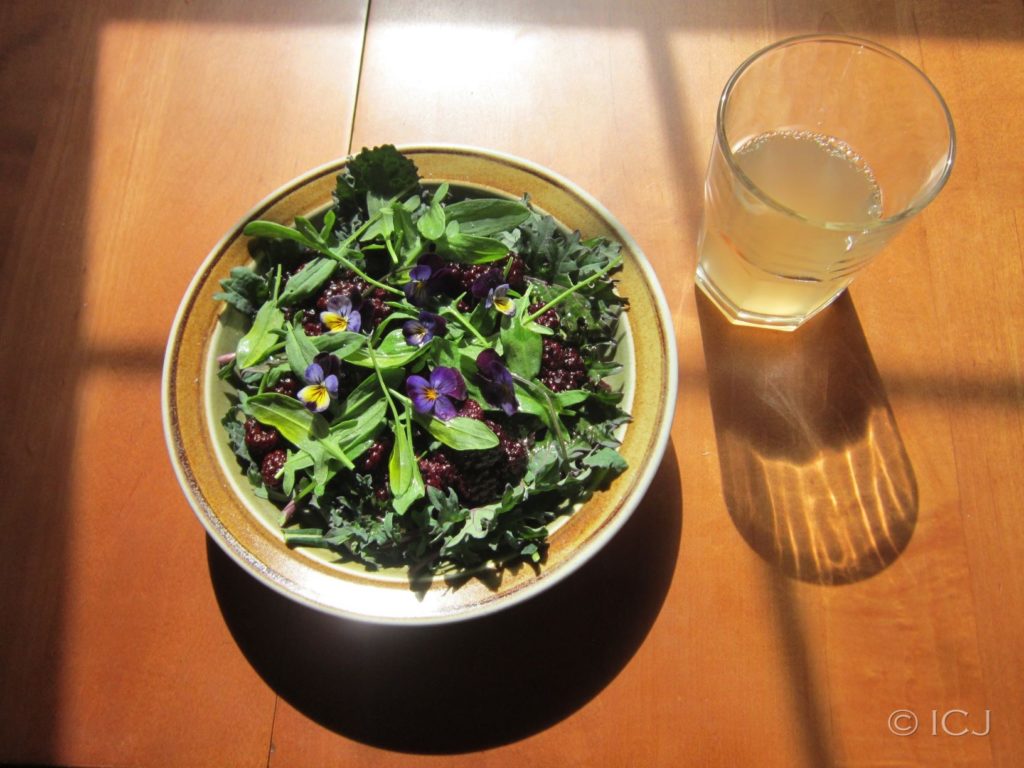
SNACKS: Fruit Leather
Just apple so far, specifically the apple mash that is a byproduct of making cider, previously frozen in gallon bags. One gallon fills several trays in my dehydrator. Ingredients and procedure need work. This first batch was palatable but uninspiring compared to the other snack food at my disposal on a normal day. On Homegrown Day April 1 my hunger level by midafternoon inspired me to eat half a sandwich baggie full.
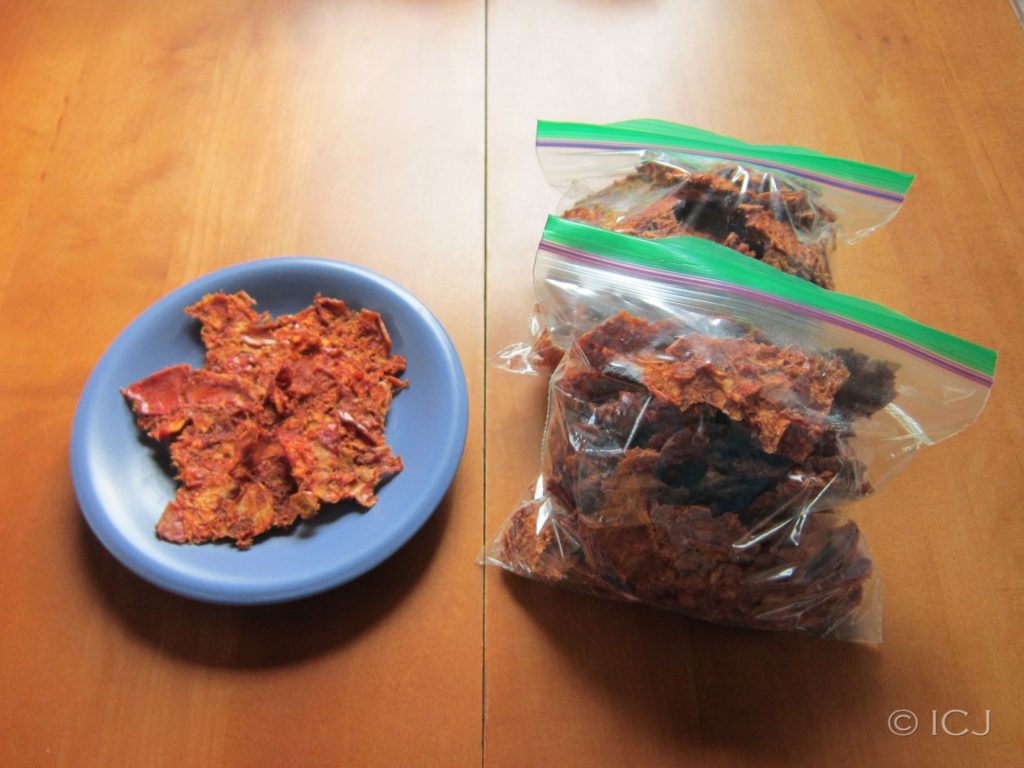
DINNER: Black Beans and Nettle Greens
1/3 c dried black beans. Half my 2020 harvest. (No other legumes survived to 1’ high, let alone maturity.) I started soaking them around noon. The other 1/3 c I am saving for Homegrown Day on May 1 because I won’t have much new yield between now and then, and all of it save the rhubarb will be green. The variety is “Cherokee Trail of Tears,” a sobering reminder of the all the forgotten and otherwise mistreated legacies that made today’s food crops possible, and that no amount of time and wise keeping will fully heal the wounds done on this land.
The shallots were seeded by someone else and came to me via the garden center in town as threadlike sprouts several inches high, just starting to resemble chives. I planted about 60. They doubled in height and grew several new leaves before being decimated by mice and slugs. Shallots, however, are wizards of survival and can resprout from a stump once they have any amount of stored energy underground. They’ll be smaller for the setback but they are still there. Partly because it was too late for the greens I had direct seeded last spring and partly because of the relative cost, culinary value, and storage properties of shallots, they became my first priority for physical defenses and slug patrol. About half survived. Shallots taste like a cross between onions and garlic but are milder and keep better than either.
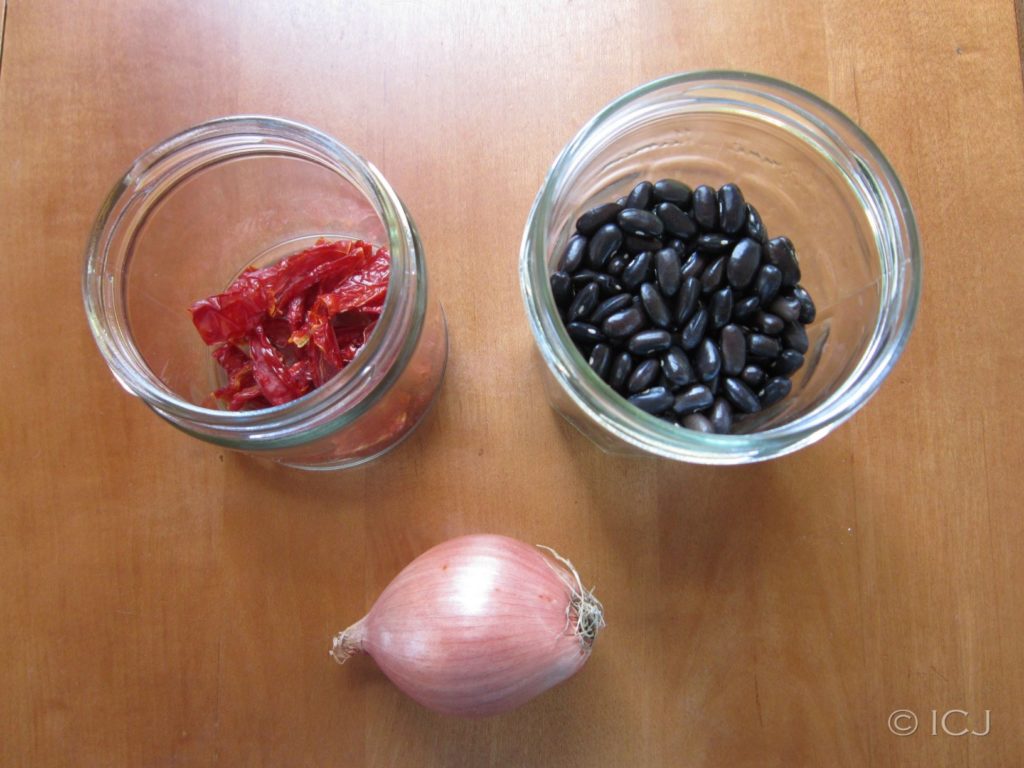
I am grateful for super-thin Atlas gloves for harvesting and prepping nettles. I have a modest population of them (nettles, not Atlas gloves) growing between the easement road and what was once a drainage ditch on my side of the road. Nettles taste the way that cut grass smells. Boiled and salted with a little olive oil, they are respectable fare, with a nutrient density rivaled by few other foods. I garnished them with sun-dried tomatoes. Actually sun-dried on a brown paper bag on a plastic mesh tray on my porch! I did not get enough tomatoes last year to can any. The few weeks I had surplus I bartered with the Cherries and dried the Roma. With an earlier start on the season and my own little greenhouse, I’m hoping this year that will change.
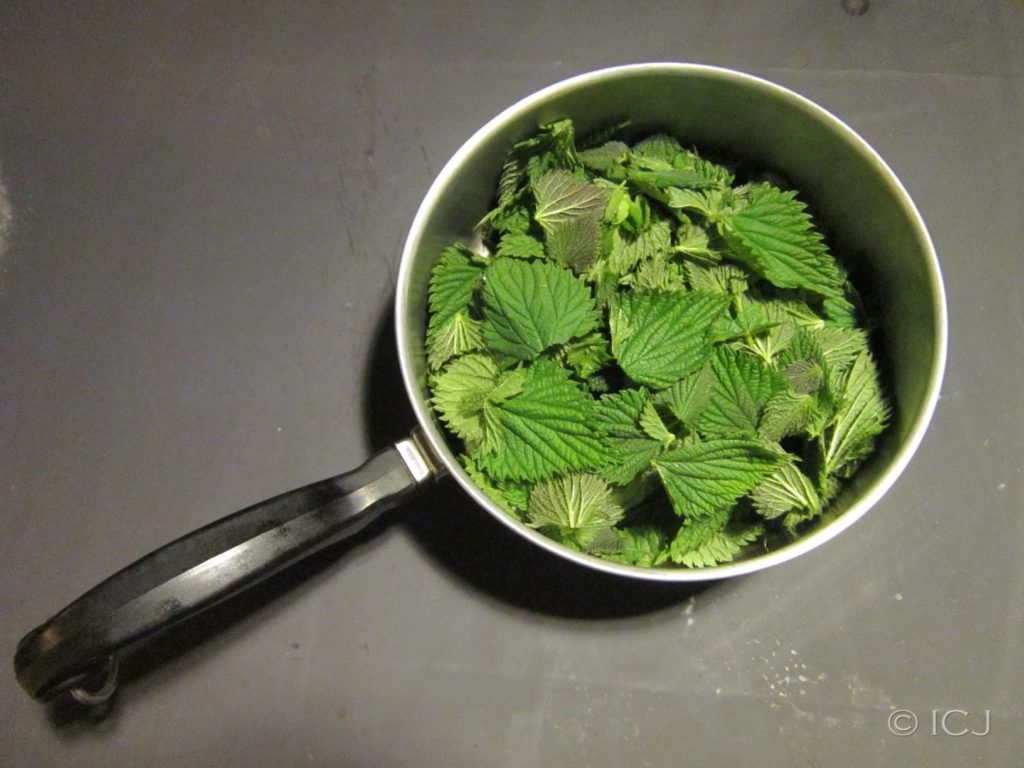
Partly due to hunger and partly due to the freshness and seed and soil quality, those were the most flavorful black beans I’ve ever had, seasoned only with shallots sauteed in olive oil and a little salt. I could’ve eaten triple the portion that I had. My vitamin & mineral to calorie ratio is pretty good on a normal day, certainly better than the average American’s. My first Homegrown food day was nearly all vitamins and minerals, with the deep flavor and color that typically accompany those. Calories, not so much. I have work to do.
Mad props to the pioneers. They didn’t have a pantry full of store-bought food to wake up to the next day. Or a whole year to prep for a day of feeding themselves. Or a chest freezer. I have work to do. I have much to learn. And that is good.
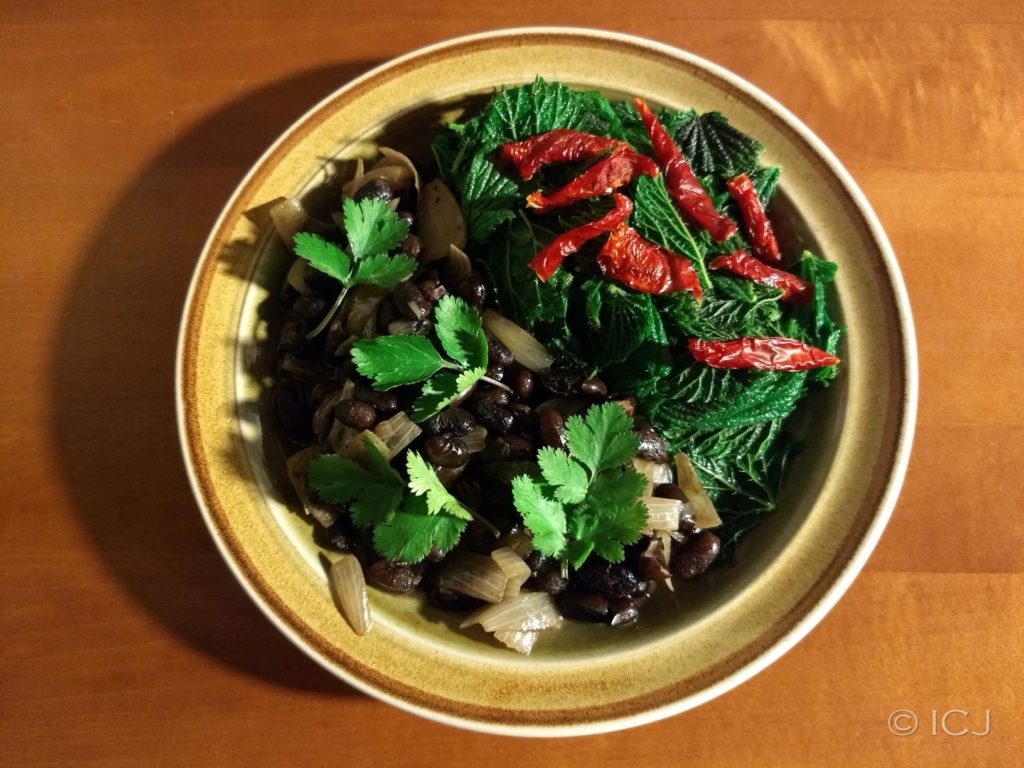
Arrival I: First Sight through Adoption Day
It was the first Saturday in January of 2019 when I clicked that link on Zillow. Three days later I was standing in the rain, mud, fog, and cheerful earnest company of Josh Anthony, who turned out to be the best buyer’s agent a girl could ask for. The fog was so thick you couldn’t see much more than 500 feet away, leaving the edges of the property blurry from where we stood and a shroud of mystery over what lay beyond. Josh and I tromped around through the ramshackle fences and soggy meadow, inspected as far as we dared the various derelict structures, confirmed the presence of a well, made a game plan, and shook hands.
[Frantic internet research, numerous phone calls back and forth with banks and contractors, hours of reading fine print, assembling financial records, and digitally signing documents ensues.]
Mortgage pre-approval. Offer. Counter. Contract. 30 day feasibility study period. GO.
It’s got potential. It meets all the basic requirements on casual inspection. It needs some cleaning up but that’ll come. The junk that has been sitting here for 5-15-50 years can sit some more. It’s a good deal.
I had been dreaming of this for over a decade, had spent dozens of hours on the internet window shopping. Three years prior I had narrowed my criteria to: Lewis County, within 30 minutes of I-5 and less than 5 minutes off pavement, 5 acres give or take. I had talked to several each of real estate agents and bankers and county officials and toured half a dozen properties on the ground. The two previous places I really liked had sold before I had a chance to work on financing for them. This time I was ready. I had learned the rules of the game and had been watching the market. I was ready, I had slowly collected the right hand of cards, and I knew I was looking at a deal.
January 28 I was back for the ‘perk test’, which is where you pay a lot of money for a large digger to come out and put six 6’ deep holes in the ground so that a soil scientist and engineer can inspect them and draw a map so that you can pay more money to the county to tell you that you can install a septic system so that you can get permission to build a home there so that a bank will lend you money. It’s a fun game.
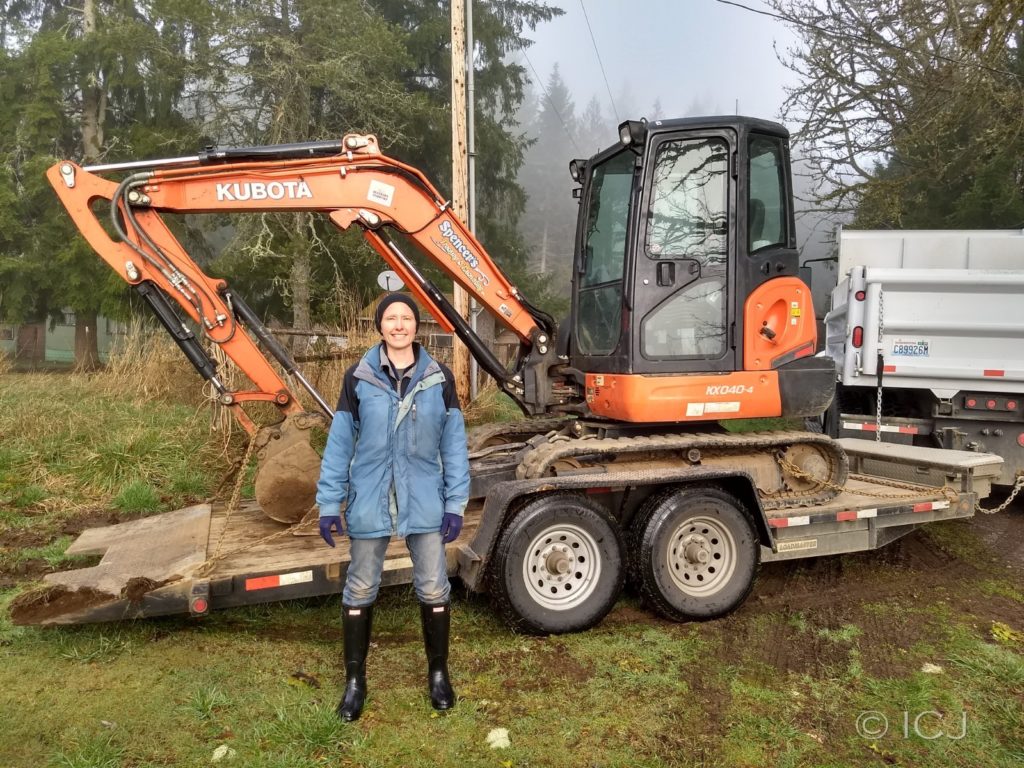
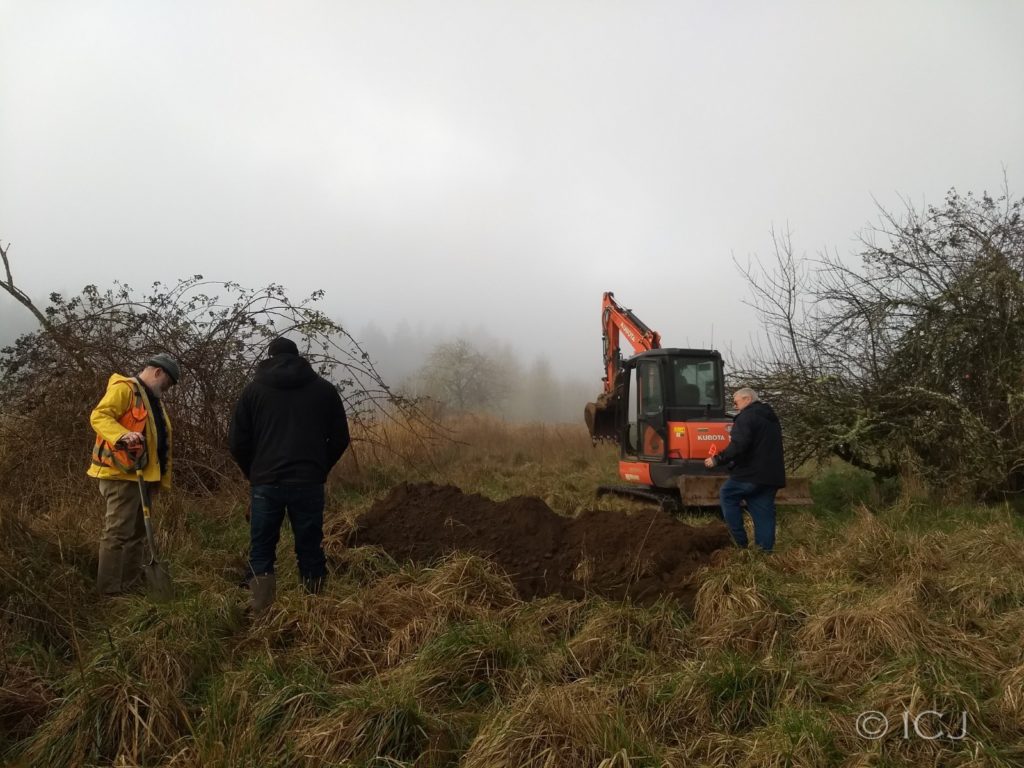
Even if it costs you upwards of a week’s wages just for the presence of the machine, it is fun to have a backhoe at your service for an hour doing the bidding of an affable and seasoned engineer who occasionally asks you questions and interprets what he sees. It is really fun to see mounds of rich crumbly soil emerge from below the overgrown pasture with its stubborn thicket of roots. (It is those roots and years of cow pie decomposition to which you owe said crumbly soil.) Yes, that’ll do nicely. That’ll grow.

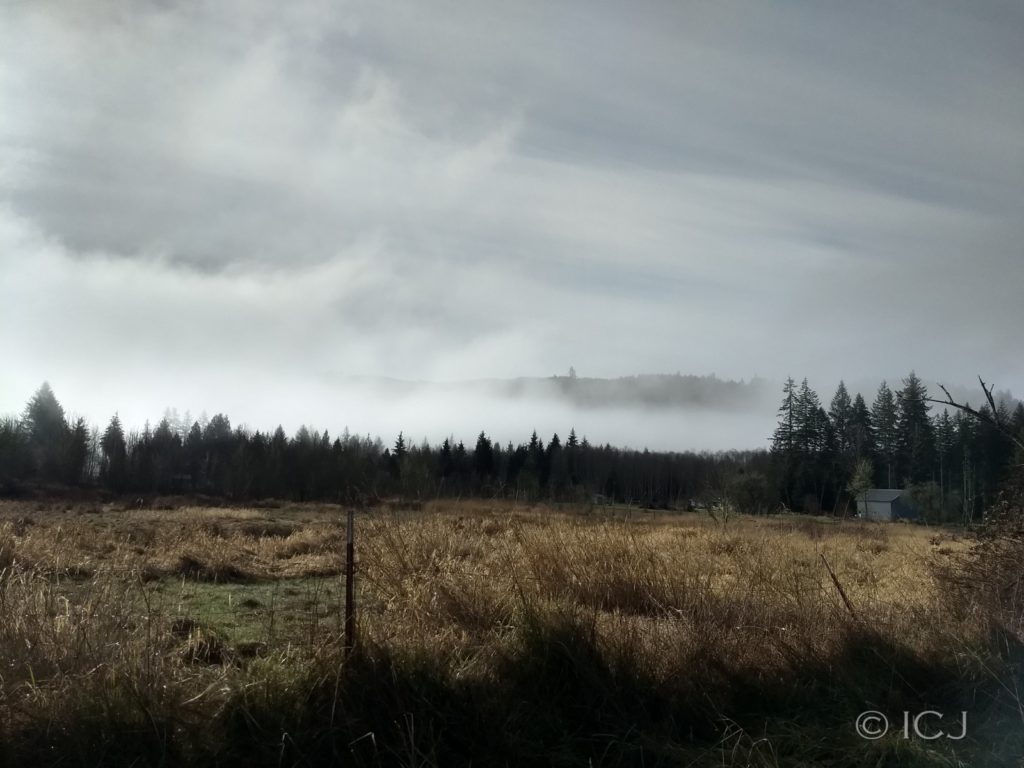
Also January 28, the fog lifted and I got to see the wider landscape for the first time. [Cue “Sound of Music” fanfare.] 2,000 foot ridgelines of timberland flanking a broad valley with Winston Creek (hidden from view by trees and steep drop-off, presence announced by regular parades or flourishes of mist) at the center of it all. Yes, I think I’ll keep it. Yes I would like to grow old here. Yes please more than anything I’ve ever wanted I want this to work out.
It would be good to have a home at all. But how amazing would it be to have this place be HOME?!??
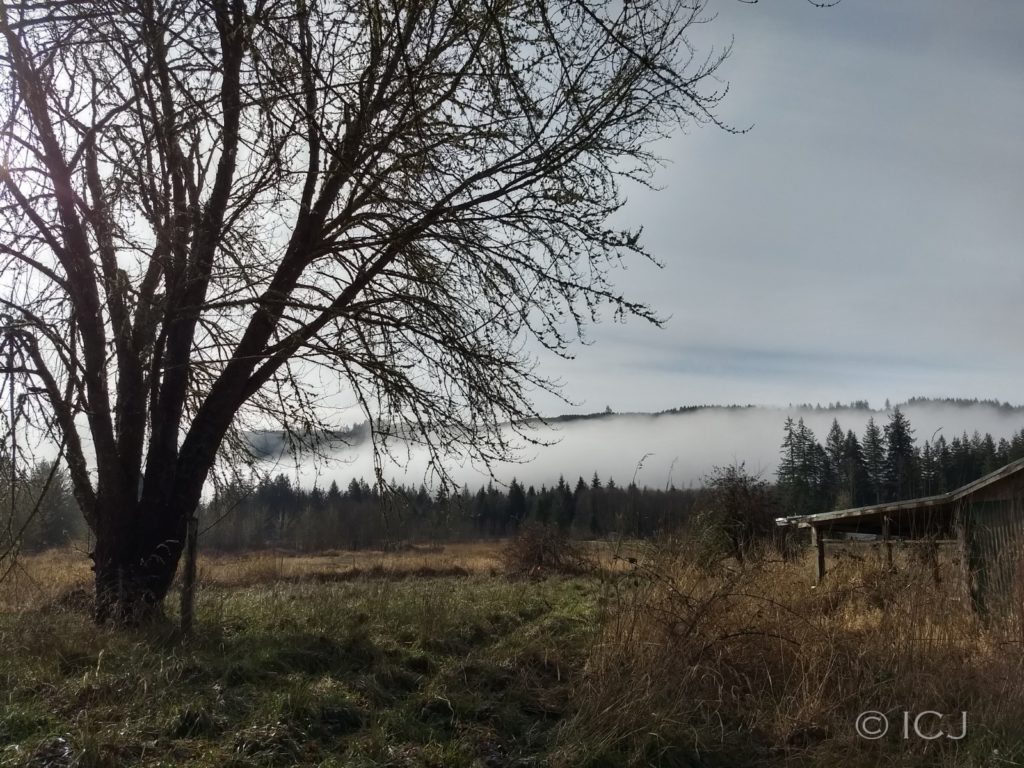
Home.
I’ve moved a lot, often not on my terms. I’ve had 28 addresses since high school and another 4 in the seventeen years before that. Four times I have been not-quite-homeless, thanks to the goodwill of stellar humans who may or may not have been close friends before they took me in, but financially unable to procure housing for myself. It was far from certain for many years that Home was something I would ever know. For many years it felt like the story of my life was packets of expired seed and leaving gardens behind.
Now I can put down roots.
Now I can build to last, establish things and see them come to fruition.
Now I can plant and harvest for myself.
Now I can have space and sustenance to share.
[Proceed to hold breath for several weeks and ache with hope mingled with anxiety about all the things that reasonably or unreasonably could go wrong.]
It passes the perk test. Well water gets a ‘thumbs up’ from the lab. Some goofy technicalities from the county and the mortgage underwriter and some cryptic legalese in the easement paragraphs but my agent and my loan officer go to bat for me and sort that out. Delay from the appraiser, whose name happens to be Scott Hamilton. He probably doesn’t think that is as funny as I think it is. [Cue 80’s ice dancing to the Beatles “When I’m Sixty-Four.”]
It passes. Bank approves. I got it. I GOT IT! I have a HOME!
Closing day set for February 22. Found someone to cover my shift. Got up well before dawn to hit the road from north Seattle before traffic started. Two hours later I found Market Street Bakery in Chehalis and enjoyed the local-talent artwork on the walls, a mocha, and a chocolate croissant fresh out of the oven that rivaled any I had in Paris. The girl at the counter, probably in her late teens, had an old-soul quality about her, warm and solid and direct. I told her my story. She grew up on a farm and she gets it. It was good to have someone to celebrate with. She remembers me and asks thoughtful questions when I stop in.
(If you’re on the road between Seattle and Portland and you need a pastry, Market Street Bakery in Chehalis is the place to go. Also they have loaves of amazing sourdough for $5. Be warned: they are not open on weekends right now.)
Josh met me at the title company and sat beside me making sure everything was in order as I glanced through, signed, and initialed umpteen times in an intimidating stack of Very Important Documents. I had gone to my bank and wired a Very Large Sum of Money a couple days before. It’s official. Just like that. Heavy envelope full of my copy of the adoption papers tucked under my arm, warm handshake from Josh and heartfelt well-wishing as we headed back to our cars.
I had remained calm and businesslike through the proceedings. Now I was giddy, euphoric combined with the weariness of all of the doings and callings and comings and goings of the past month and a half. Less than 7 weeks from seeing the listing on Zillow to owning it. I have a Home.
It was breezy and snowing lightly as I drove down Highway 12. As I turned onto my road, I put in George Winston’s “December”—fitting soundtrack for the moment—and as I rolled down the winding tree-lined road the joy and relief swelled in my chest. Coming home, really Home, for the first time. I pulled off the easement road in front of the For Sale sign and sat in my car and cried.
Naturally I am going to spend my first night as a landowner camping. Not about to be deterred by the February part. When you are recently descended from Scandinavian peasants and from the northern Midwest, freezing isn’t cold. It also helps to have a closet improved by a decade of employment at REI. The Swedes have a saying: “There is no bad weather, only bad clothes.” In Swedish, it rhymes.
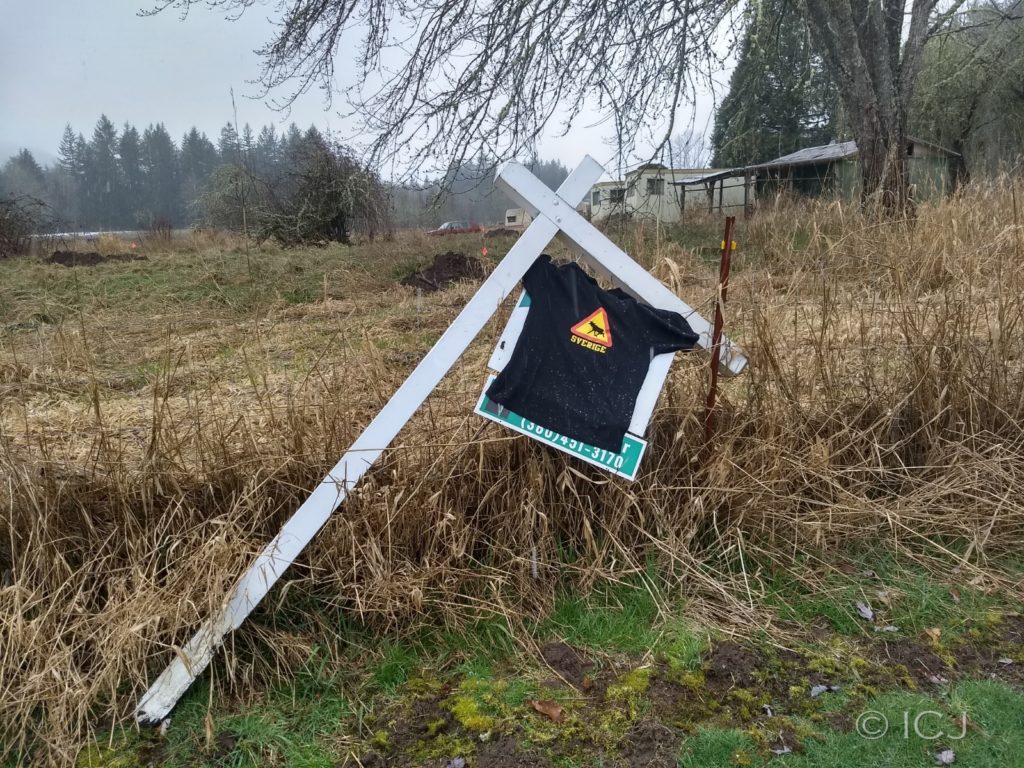
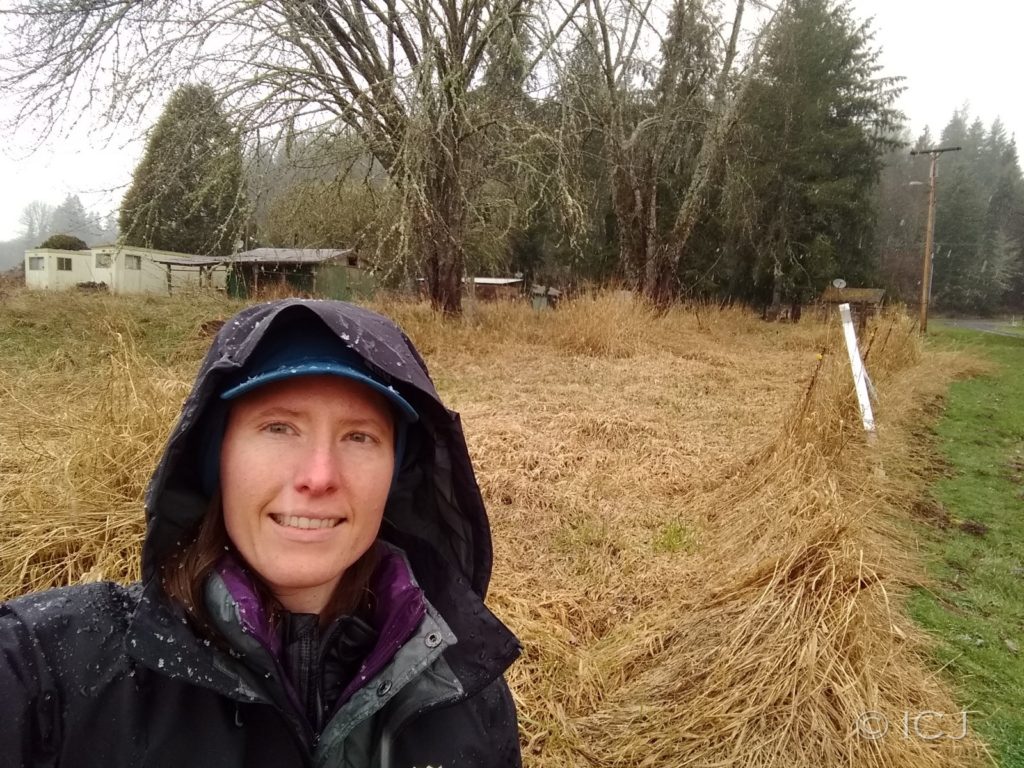
Bundled up, pitched my tent, and set up the first of what would become a series of Little Blue Roofs: a 6’x8’ tarp held up by the fence, some utility cord, and large sticks that had fallen down around the old maple trees. Built a fire. Settled in for a celebration picnic, contentedly surveying my domain. Not long after dark I crawled into my tent and read a few pages of Wendell Berry (specifically his essay “A Country of Edges,” a fitting benediction on my place, its name that found me before I found it, and my vision for my life’s work here) before dropping off to sleep.
Welcome to Edgewild Farm. I am home.
